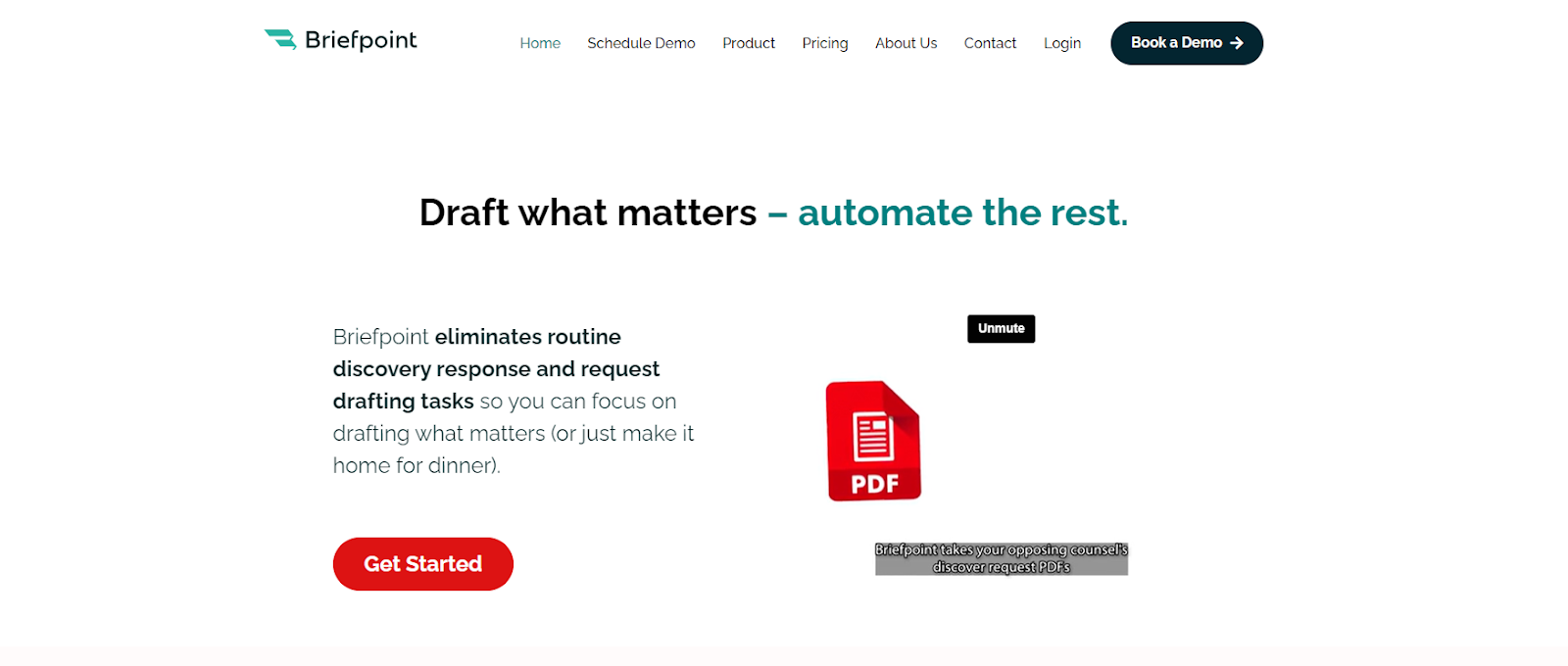How Can Law Firms Increase Efficiency With Tech?
How Can Law Firms Increase Efficiency With Tech?
Most legal tech solutions are designed with one central goal in mind: to make legal firms more efficient.
However, optimized efficiency doesn’t always happen instantly. While more and more law firms are leveraging legal tech today, some are still struggling to use these solutions properly.
If you’re in the same boat, don’t throw in the towel just yet. What if you could maximize your workflow with the right tech tools? Here’s how to make that possible.

Types of Legal Technology
Before we go into using legal tech properly, let’s list the most common tech solutions law firms use to improve their efficiency, productivity, and client experience.
From automating tedious tasks to enhancing collaboration, law firms can significantly benefit from the array of technologies emerging in the tech sector. Take a task, any task–like dealing with paperwork or tracking hours–and you’ll likely find a tool waiting in the wings to make it easier.
To optimize their operations, law firms can turn to various legal technologies that help streamline tasks and increase productivity.
Document Automation Tools
For law firms, the right tools can spell the difference between wasting hours and free time to focus on high-priority cases. Rather than drafting documents from scratch every time, some document automation tools use AI to draft legal documents like discovery responses quickly.
This means fewer mistakes, consistent quality, and more time for lawyers to focus on important work. Plus, clients get their documents faster, which makes everyone happy.
Case Management Software
Law firms rely heavily on case management software. It’s an indispensable ally for legal professionals aiming to stay on top of their caseload.
All your case information, neatly organized in one spot, frees you up to tackle your workload without the stressful juggling act of separate systems and mounds of paperwork.
With this software, you can track important dates, deadlines, and tasks, which helps make sure you don’t miss anything important. It keeps all your case documents, emails, and notes together, so you can easily find and share information with your team.
It also assists with time tracking and billing for simpler billing and invoicing.
Document Management Software
Any law firm that’s serious about staying organized and efficient needs a solid document management system in place. File organization is their boon, keeping every sheet of paper in its rightful place and simple to track down.
It also stores all your files digitally, so you can quickly search and retrieve what you need without digging through piles of paper or scattered digital folders.
With everything in one central spot, managing documents becomes a breeze. You can categorize and tag files for quick access, and features like version control ensure you’re always working with the latest document version.
Working together just got a lot simpler, thanks to this handy feature. Sharing and accessing files is straightforward, cutting down on time-wasting email exchanges. Plus, secure access controls keep sensitive information protected and only accessible to the right people.
Billing and Time Tracking Tools
Billing and time-tracking tools are must-haves for law firms to keep track of billable hours and manage invoices efficiently. These tools help lawyers log their time accurately so that every minute of work is accounted for.
Automation makes short work of hour recording, banishing the irritation of errors and liberating the time you need to focus on more pressing matters. You can easily track how much time you spend on different tasks and cases, which helps you bill clients correctly.
Invoicing becomes much simpler, too. Tracked hours convert effortlessly into accurate invoices, which simplifies the billing process and reduces administrative headaches.

Online Payments Software
Online payment software is a convenient tool for law firms, making it easier to handle client payments. Instead of relying on traditional methods like checks or bank transfers, clients can pay their bills online quickly and securely.
This software allows clients to pay using various methods, such as credit cards or electronic transfers, which gives them flexibility and convenience. For the law firm, it means faster payments and less time spent chasing down unpaid invoices.
Security is the key feature, with encryption and other measures to make sure that payment information is protected.
Electronic Signature Solutions
Ever wondered how to speed up the document signing process at your law firm? Electronic signature solutions are the answer. By giving clients the ability to digitally sign documents, annoying lag times and physical correspondence become a thing of the past.
With electronic signatures, you can send documents to clients with just a few clicks. Clients can then sign them from anywhere using their computer or mobile device. Streamlining equals speed and simplicity–a double blessing that benefits each and every person involved.
These solutions are secure and ensure that signatures are legally binding and documents are protected. Plus, they keep a digital record of all signed documents, so it’s easy to track and retrieve them when needed.
Automated Client Intake Forms
Automated client intake forms allow new clients to provide their information online, which simplifies the intake process and saves valuable time.
Instead of dealing with paper forms or back-and-forth emails, clients can fill out their details at their convenience. Client data is then automatically organized and stored in your system, which makes it easily accessible for your team.
Automated client intake forms not only speed up the process but also reduce error and legal risks. With digital forms, there’s less chance of missing or incorrect information, so you have everything you need from the start.
Legal Research Tools
Legal research is a whole lot easier with the right tools. With instant access to a massive library of information, you can track down relevant cases, statutes, and precedents in no time.
Imagine being able to search for a specific topic, keyword, or case and getting instant results. Instead of drowning in outdated information, you’ll have the power to zip through updates and refresh your perspective in no time.
But what really sets these tools apart are the extras, like annotations, highlights, and bookmarks, that keep your research tidy and easily accessible whenever you need to reference it.
Why Are Some Law Firms Inefficient With Tech?
Many law firms grasp the benefits of embracing technology, but for some, the gap between that understanding and tangible results remains stubbornly wide, leaving them in a cloud of inefficiency. More often than not, a few specific pain points are to blame.
For one, some lawyers often shy away from change for the sake of tradition, even if it means improving their productivity.
Plus, without the right know-how, even the flashiest tools can quickly become more hindrance than help and leave staff to wrestle with integration.
Cost is another concern—many firms worry about the initial investment required for new technology, even though it can save money in the long run.
Integration issues also play a role. If different systems don’t work well together, it can lead to a disjointed workflow where information is siloed, and tasks become more cumbersome.
Lastly, a nagging concern about security can stalemate a firm’s growth. As keepers of confidential information, law firms must be cautious when it comes to embracing digital innovation. With confidentiality at stake, concerns about data security are unavoidable.
Addressing these issues with an open mind, proper training, thoughtful cost analysis, ensuring system compatibility, and prioritizing security can help law firms overcome these challenges and significantly improve their efficiency with tech.
How to Make Your Law Firm More Efficient With Tech
Making your law firm more efficient with technology doesn’t have to be a daunting task. Here are some practical steps to help you get started and make the most out of tech tools:
1. Start Small
Begin with one or two tech tools that address your most pressing needs. This way, you can gradually get used to new systems without overwhelming your team. Starting small allows you to manage the transition better and build confidence in using technology.
Here are some repetitive and often time-consuming tasks you can automate with new legal tech:
Document creation
Email management
Appointment scheduling
Billing and invoicing
Time tracking
Data entry
Client intake forms
Legal research
Task reminders
File organization
Follow-up emails
Case updates
Expense tracking
Report generation
Workflow management
2. Provide Training
Getting everyone in your firm comfortable with new technology is key to making it work.
First things first: get your team familiar with the new tools by organizing some live training sessions that zero in on each one. These could be workshops, webinars, or hands-on sessions where your team can learn and practice in a relaxed setting.
Whether you’re a newbie or a pro, make the learning process smoother with a diverse range of resources featuring user-friendly guides, online tutorials, and instructional manuals that get straight to the point.
These will help your staff get familiar with the new tools at their own pace. It’s also a good idea to have a go-to person or team who can answer questions and help troubleshoot any issues that come up.
Resistance to change is natural, but with proper training, that friction begins to fade, and people start to adapt and thrive. You can almost see a boost in confidence when someone masters a new technology. Suddenly, they’re less apt to second-guess themselves and make costly mistakes.
3. Seek Feedback
Regularly ask your team for their input on the tools you’re using. Can you truly count on them to get the job done? What challenges are standing in their way? In order to revise and perfect, this feedback is the perfect guiding light shining a spotlight on what needs fixing.
Involving your team in the decision-making process can also increase their buy-in and commitment to using the new tools.
4. Focus on Integration
Integrated systems simplify processes and make it a breeze to manage all aspects of your practice from one central platform. Imagine having your case management, document automation, billing, and communication tools all working together in harmony.
Errors and duplications simply disappear when you unify your system, leaving you with a leaner, more efficient operation. When your tools are synced, information flows seamlessly and everyone has access to the most up-to-date data.
When your team collaborates smoothly, you’ll get work done faster and with more precision—and that means delighted clients.
5. Stay Updated
Technology for the legal sector is always evolving, so stay updated with the latest advancements and trends. Regularly review and update your tech tools to ensure that your firm is benefiting from the most current and effective solutions.
An edge over the competition doesn’t happen overnight (especially in the legal industry); it’s the result of clever strategic planning that pinpoints opportunities for improved efficiency.

Invest in Tech Solutions Today
Legal tech solutions are designed to optimize your law firm’s operations, but it doesn’t happen instantly. Even with the best tech tools in your stack, efficiency can wane if you don’t know how to use them correctly.
It’s time to turn your tech investments into tangible results, so use these strategies to make it happen. While it can take some time and maybe even a bit of a learning curve, leveraging technology will ultimately make your firm more consistent, productive, and efficient.
If you’re new to legal tech, start with a tool that will bring you the most ROI yet is very easy to implement: Briefpoint.ai. Here’s a quick look at what you can do with it:
Upload your discovery request: Briefpoint’s machine-learning system will automatically start extracting information from your document.
Add objections and responses: Briefpoint will create a caption with most of the routine details already filled out. You can then add your objections to each request or interrogatory using the checklist.
Collect and add client responses: With Briefpoint Bridge, you can easily gather and input client responses. Select your questions, send them to your client, and then insert their replies into your document without manual effort.
Finish up: Once you have a draft, download the document in MS Word and make your final touches. It’s that simple!
Maximize Your Tech ROI With Briefpoint
Discovery responses cost firms $23,240, per year, per attorney. $23,240 estimate assumes an associate attorney salary of $150,000 (including benefits – or $83 an hour), 20 cases per year/per associate, 4 discovery sets per case, 30 questions per set, 3.5 hours spent responding to each set, and 1800 hours of billable hours per year.
Book a demo and save on these costs with Briefpoint.
FAQs About Legal Tech
How can document automation help my law firm?
Document automation can save time and reduce errors by using templates to create standard documents quickly and accurately.
What is practice management software?
For law firms and legal departments, keeping track of cases, deadlines, and client information can be a monumental task. However, practice management software makes it a breeze, centralizing everything in one easy-to-use platform.
Why should my firm use online payment software?
Picture this: no more wasted hours chasing down clients for payment. Online payment software streamlines the process, allowing clients to pay quickly and efficiently so you can refocus on driving growth.
How do electronic signatures benefit law firms?
Electronic signatures speed up the process of getting documents signed and returned, which eliminates the need for physical copies and in-person meetings, as well as increases cost savings.
What are automated client intake forms?
Automated client intake forms allow new clients to provide their information online, streamlining the onboarding process and saving time.
The information provided on this website does not, and is not intended to, constitute legal advice; instead, all information, content, and materials available on this site are for general informational purposes only. Information on this website may not constitute the most up-to-date legal or other information.
This website contains links to other third-party websites. Such links are only for the convenience of the reader, user or browser. Readers of this website should contact their attorney to obtain advice with respect to any particular legal matter. No reader, user, or browser of this site should act or refrain from acting on the basis of information on this site without first seeking legal advice from counsel in the relevant jurisdiction. Only your individual attorney can provide assurances that the information contained herein – and your interpretation of it – is applicable or appropriate to your particular situation. Use of, and access to, this website or any of the links or resources contained within the site do not create an attorney-client relationship between the reader, user, or browser and website authors, contributors, contributing law firms, or committee members and their respective employers.
How Does Legal Tech Help With Compliance (+10 Common Risks)
How Does Legal Tech Help With Compliance (+10 Common Risks)
Law firms are getting a taste of the future courtesy of legal technology. No more hours spent on repetitive tasks, no more regulatory surprises, and no more sleepless nights worrying about data breaches.
What if you could outlaw mistakes and stay current with the latest rules and regulations? These tools make it happen and free you up to tackle more substantial legal work.
In this guide, we talk about the role of tech in legal compliance, how to modernize your own compliance strategy, and the best tool to start with.

What is Legal Compliance?
Legal compliance is all about following the rules and regulations that apply to your business. This involves mapping their operations to laws that dictate client confidentiality, financial prudence, and good old-fashioned common sense.
Key Elements of Legal Compliance
All law firms and legal departments need a solid compliance management strategy in place. To do that, they need to understand the most important elements of legal compliance obligations:
Understanding regulations: Law firms need to know the ins and outs of the laws and regulations that apply to their work. This includes everything from professional ethics to data protection laws.
Setting up policies: Law firms need clear policies and procedures to stay compliant. Building trust requires more than good intentions—it demands tangible safeguards like data protection policies, confidentiality agreements that client teams can rely on, and effective anti-money laundering measures that kick in automatically.
Training and awareness: Everyone in the firm needs to be aware of compliance requirements and trained on how to follow the firm’s policies. Regular training sessions help keep everyone up-to-date with the latest rules.
Monitoring and reporting: Law firms should constantly check their compliance status and report any issues. This involves regular audits and checks to make sure everything is running smoothly and by the book.

10 Common Compliance Risks Law Firms Face
Law firms have their hands full when it comes to staying compliant. There are several common risks they need to be aware of and manage properly. Here are some of the key ones:
1. Data Breaches
Law firms deal with a lot of sensitive information, from client details to case documents.
Picture this: a sophisticated cyber attack exposes your client database, putting sensitive information at risk. The financial fallout is immediate⎯hefty fines and lawyers’ fees start adding up. But the real damage is to your company’s reputation, which may never fully recover.
Unauthorized access is like an unwanted houseguest, you never want it to happen, and strong cybersecurity measures are the only way to keep it from showing up uninvited.
2. Client Confidentiality
Keeping client information confidential is a must. If client data gets leaked or mishandled, it can cause legal troubles and harm the client-lawyer relationship. Law firms should have strict policies to protect client confidentiality all the time.
3. Anti-Money Laundering (AML)
Law firms must make sure they’re not inadvertently helping clients launder money. Having a procedure in place for flagging and reporting fishy behavior is crucial⎯it’s the first line of defense against suspicious activities.
Skipping AML regulations can bring the hammer down on your business. Penalties can be harsh, and the consequences can be very serious.
4. Regulatory Changes
Laws and regulations are always changing. Keeping up with these changes can be tough, but it is necessary to stay compliant. Law firms can’t afford to get caught off guard by new rules—they need to stay vigilant and adjust their strategies on the fly.
5. Document Management
Managing a ton of documents can be a nightmare. Imagine the sinking feeling when you realize that crucial paperwork has vanished and it’s a compliance nightmare waiting to happen.
A document management system guarantees that kind of crisis never happens, freeing up law firms to concentrate on the law, not paperwork.
6. Conflict of Interest
Law firms must avoid situations where there might be a conflict of interest. To prevent divided loyalties, they draw a hard line: no clients with competing agendas are allowed under their roof. Proper screening processes are needed to spot and manage potential conflicts.
7. Ethical Violations
Following professional ethics is key to maintaining a law firm’s integrity. Ethical violations, like mishandling client funds or misrepresenting facts, can lead to disciplinary actions and losing the license to practice.
8. Billing and Fee Disputes
Clear and accurate billing practices are essential to avoid disputes with clients. Overbilling or failing to properly document billable hours can result in compliance issues and damage client relationships.
9. Employment Law Compliance
Law firms, like any other business, must comply with employment laws. At the core of it all are fair hiring practices, accurate employee classification, and a deep understanding of labor laws.
By nailing these fundamentals, you’ll set your organization up for success. Miss the mark on compliance, and you might as well write a check to your legal adversaries, or the government, for that matter.
10. Client Intake and Screening
Properly vetting clients before taking on new cases is important to make sure they’re legitimate and not involved in illegal activities.
Why do high-risk clients keep you up at night? It’s because one misstep can trigger a domino effect of financial and reputational damage. That’s why a rigorous client intake process is very important.

How Legal Technology Can Help With Compliance
Legal tech can be a real lifesaver for law firms trying to stay compliant. It’s like having a second pair of eyes on your project, tackling monotonous tasks, keeping your workspace organized, and flagging anything that needs attention.
Here’s how legal tech can help law firms with compliance:
Automated Document Management
Legal tech tools do the heavy lifting so you can focus on locating that one crucial document amidst the stacks. With automated document management systems, you can make sure all important documents are safe, secure, and easy to locate.
Think of the countless hours you’ll save by having a well-organized document management system. No more searching high and low for misplaced files or wading through a sea of paperwork during audits.
Keeping Up with Regulatory Changes
Staying up-to-date with the latest regulations can be a hassle, but legal tech can handle it for you. These tools monitor regulatory changes and alert you when something new comes up. This way, you’re always on top of the latest rules without having to manually track them.
Maximizing Data Security
Legal tech solutions often come with top-notch security features to protect sensitive information.
To keep client information private, we’ve got a trio of protective measures in place: encryption to scramble data, access controls to limit who sees what, and regular security checks to identify potential vulnerabilities. This is incredibly important given the sensitive nature of the data legal professionals handle.
Making Reporting Easier
Reporting can be a real pain, but legal tech simplifies it. These tools can automate the reporting process and make sure all necessary information is included and submitted on time. With fewer errors to worry about, the whole reporting process becomes far less of a headache.
Helping with Anti-Money Laundering
Legal tech can assist with anti-money laundering efforts by automating client due diligence checks and monitoring transactions for suspicious activity. Monitoring for suspicious activity becomes a whole lot easier, and that’s a big deal when it comes to staying compliant with AML regulations.
Smoother Client Intake and Screening
Legal tech tools simplify the client intake process by automating background checks and risk assessments. This can help you make sure new clients are legitimate and not involved in illegal activities, which reduces the risk of compliance issues later on.
Automated Document Generation
Legal tech can be a real game-changer when it comes to creating documents. By automating this process, it saves a ton of time and cuts down on errors.
For instance, automated discovery document drafting is a lifesaver. It helps law firms quickly whip up accurate and comprehensive documents needed for the discovery phase of litigation. This means all the necessary info is included, and everything sticks to compliance requirements.
Increasing Efficiency
For lawyers, time is money. By offloading administrative duties and making data readily available, legal tech amplifies productivity and empowers you to take on more billable hours or simply enjoy a better work-life balance.
Handing off tedious tasks to automation frees up staff to tackle the more important work, and that’s not all. It also reduces the likelihood of human error, a major compliance headache.
Ensuring Consistency
Consistency is important for compliance, and legal tech helps ensure that all procedures are followed the same way every time. With standards nailed down, you’ll worry less about flying under the compliance radar.
Types of Tech Designed For the Legal Profession
Legal technology includes a variety of tools designed to improve the efficiency and effectiveness of legal services. Here are some key types:
Document management systems: Organize, store, and retrieve legal documents to make it easy to manage large volumes of paperwork and ensure compliance with legal standards.
Case management software: Helps law firms manage their cases, track deadlines, and organize client information, which can improve overall efficiency and client service.
Contract management software: Automates the creation, tracking, and management of contracts to manage compliance and reduce manual errors.
Legal research tools: Provide quick access to legal databases, case law, statutes, and other legal resources, which makes research faster and more comprehensive.
Time tracking and billing software: Tracks billable hours and automates invoicing for accurate billing and better financial management.
Client Relationship Management (CRM) systems: Manage client interactions, track communication, and improve client service through organized client data.
Litigation support software: Assists with trial preparation, including managing exhibits, witness information, and case timelines.
Legal analytics tools: Analyze legal data to identify trends, predict case outcomes, and provide insights that inform legal strategy.
Are Legal Tech Solutions Foolproof?
While tech solutions offer many benefits for the legal industry, they’re not completely foolproof. No technology is perfect, and there can be occasional glitches or bugs that disrupt workflows.
The good news is that they’re usually just a temporary setback. While tools can free up our time, they can’t think for us, that’s why we need to stay involved. Relying solely on technology without regular checks can lead to complacency, and critical errors might go unnoticed.
Additionally, not all legal tech solutions are created equal; some may lack the robustness needed for complex legal tasks, and firms must carefully choose the right tools for their specific needs.
Moreover, legal tech often involves a learning curve. The people behind legal teams need training that’s both thorough and sustained. Only then can they wield these tools with confidence and precision.
There’s also the risk of cyber threats; despite advanced security features like encryption, no system is entirely immune to breaches. Law firms can’t afford to let their guard down – they need to regularly bolster their defenses to stay safe from rapidly evolving security risks.

How to Use Legal Technology Solutions Responsibly
Using legal tech solutions the right way ensures your law firm gets the most out of these tools while keeping risks in check. Here are some practical tips for making the most of legal technology:
Regular Training
Keeping your team well-trained is key, so stay on top of your tools with regular training sessions. This way, everyone’s on the same page when it comes to getting the most out of them.
This includes understanding new features, knowing how to fix common issues, and being aware of best practices for security and compliance.
Backup Plans
Even the best tech can fail, so having backup plans is crucial. This could mean regular data backups, alternative ways to complete tasks if the tech fails, and manual processes to fall back on during system outages.
Stay Updated
Keeping your tech tools updated is important for maintaining security and functionality. Software updates often include important security patches and new features that can improve performance.
An outdated toolkit is like an open door to cyber threats. Close that door by updating regularly, and you’ll not only be protected but also be able to seize new opportunities as they arise.
Monitor and Review
Regularly monitoring and reviewing your legal tech tools can help catch issues early. System troubleshooting, feedback analysis, and regular check-ins are just a few ways you can guarantee your tools are working as they should.
By tracking your tools’ performance, you’ll be able to spot what’s working and what needs an overhaul and make the necessary tweaks.
Combine with Best Practices
Legal tech should complement, not replace, established best practices. To avoid any compliance issues, revisit the basics. Regularly scheduled team syncs and spot-checks by hand will help you stay on track.
Remember: Combining legal tech with human oversight ensures you have a strong system in place.
Data Security
Prioritize data security by implementing strong encryption, access controls, and regular security audits.
Make sure your legal tech solutions follow the highest standards of data protection to safeguard sensitive client information. Take the time to educate your legal team on the dos and don’ts of data security. They’ll be the first line of defense against potential breaches.
Ethical Use
Make sure your use of legal tech aligns with your firm’s ethical standards. Clients need to know when technology is involved, and it’s your job to guarantee that automation doesn’t come at the cost of top-notch service. Regular ethical check-ins are a must, too.
A Faster Discovery Phase Without Putting Compliance at Risk
Discovery documents need to follow specific rules to stay compliant, but that doesn’t mean you should spend hours on each document to guarantee its accuracy and consistency.
What if you could finish this tedious task in minutes without putting your compliance at risk?
Enter Briefpoint.ai, a generative artificial intelligence tool that can help you draft discovery documents in just a few clicks. That’s not all. Briefpoint keeps your data secure through several key measures.
We use top-notch encryption for data both in transit and at rest. Regular automatic backups and redundant servers make sure your data is always protected, and our development practices include strict code quality standards and security reviews.
Here’s a sneak peek at what you can do with Briefpoint:
Upload your discovery request. Briefpoint’s machine learning system will automatically start extracting as much information as it can from your document.
Add objections and responses. At this point, Briefpoint has created a caption with most of the routine stuff already filled out for you. From here, you can add your objections to each request or interrogatory using the checklist.
Collect and add client responses: If you need to do so, Briefpoint Bridge can help you collect and input client responses into your documents without doing it all manually. Select your questions, send them to your client, and then plug in what they send back.
Finish up. Once you have a draft, you can download the document on MS Word and finish up there. It’s that easy.
Upgrade Your Legal Practice With Document Automation
Discovery responses cost firms $23,240, per year, per attorney. $23,240 estimate assumes an associate attorney salary of $150,000 (including benefits – or $83 an hour), 20 cases per year/per associate, 4 discovery sets per case, 30 questions per set, 3.5 hours spent responding to each set, and 1800 hours of billable hours per year.
Book a demo and save on these costs with Briefpoint.
FAQs About Legal Tech and Compliance Management
What is legal tech?
Legal tech refers to technology tools and software designed to help law firms manage their operations, including compliance, document management, and data security.
How does legal tech improve compliance?
Legal tech improves compliance by automating routine tasks, monitoring regulatory changes, improving data security, and streamlining reporting processes.
Can legal tech replace human oversight?
No, legal tech is not a replacement for human oversight. It should be used as a helpful tool to support compliance efforts, but regular checks and balances are still necessary.
What are the risks of relying solely on legal tech?
Relying solely on legal tech can lead to new problems, such as tech glitches and a lack of human oversight. It’s important to use legal tech responsibly and have backup plans in place.
What are legal technology professionals?
Legal technology professionals are experts who implement and manage tech solutions for legal practices. They help law firms provide convenient legal service delivery and manage compliance using various legal tech tools, combining knowledge of law and IT.
How can law firms stay updated with regulatory changes using legal tech?
Legal tech tools can monitor regulatory changes and alert firms when they need to take action. This helps firms stay on top of the latest rules and regulations.
The information provided on this website does not, and is not intended to, constitute legal advice; instead, all information, content, and materials available on this site are for general informational purposes only. Information on this website may not constitute the most up-to-date legal or other information.
This website contains links to other third-party websites. Such links are only for the convenience of the reader, user or browser. Readers of this website should contact their attorney to obtain advice with respect to any particular legal matter. No reader, user, or browser of this site should act or refrain from acting on the basis of information on this site without first seeking legal advice from counsel in the relevant jurisdiction. Only your individual attorney can provide assurances that the information contained herein – and your interpretation of it – is applicable or appropriate to your particular situation. Use of, and access to, this website or any of the links or resources contained within the site do not create an attorney-client relationship between the reader, user, or browser and website authors, contributors, contributing law firms, or committee members and their respective employers.
5 Best Legal AI Applications to Simplify Litigation
5 Best Legal AI Applications to Simplify Litigation
Law firms are always in a never-ending race to the top, and the means to stay competitive change over time.
In recent years, the boon has become artificial intelligence. While still relatively new for this particular industry, AI has proven to be a much better investment for efficiency and profitability than, say, hiring more people or spending more time in the office.
But how exactly does AI make life easier for law firms and in-house legal departments?

What is Artificial Intelligence?
Artificial intelligence isn’t a brand-new technology, but law firms are only recently coming to learn to adopt it. So, before we talk about AI tools for lawyers, let’s take a closer look at what AI is and what it can do.
AI refers to the capability of a machine to imitate intelligent human behavior. Essentially, it’s about creating systems that can perform tasks that would normally require human operation, such as recognizing speech, making decisions, translating languages, and identifying patterns.
AI can range from basic automation (like sorting emails) to more complex functions (like driving cars). However, for the legal industry, the central goal of AI is to make traditionally tedious tasks much faster, easier, and more consistent.
Machine Learning (ML)
Machine Learning (ML) is a core part of AI that involves algorithms and statistical models that allow computers to perform specific tasks without using explicit instructions. Instead, these systems learn and improve their performance based on the data they process.
This learning process can be supervised, unsupervised, or semi-supervised, and it’s widely used in applications ranging from email filtering and recommendation systems to more advanced predictive analytics in industries like law and finance.
Natural Language Processing (NLP)
Natural Language Processing, or NLP, sits at the crossroads of tech and language. It revolves around teaching computers how to understand and speak human language.
NLP makes it possible for machines to translate languages, follow voice commands, summarize big chunks of text, and even write up text that sounds human. This technology is behind why your digital assistant can understand you and respond in a way that actually makes sense.
Large Language Model (LLM)
A large language model (LLM) is an advanced AI tool designed to mimic human language in a useful manner. It learns from a massive pile of data—like books, articles, and websites—to grasp grammar, context, and the ways we communicate.
This data, when combined with human feedback, allows the model to understand and respond to text inputs, which makes it incredibly useful for things like chatbots, helping with translations, or generating content.
The Use of AI in the Legal Industry
As we’ve said before, the use of AI is still fairly new for legal professionals for several reasons. For one, the legal field is steeped in tradition and often prefers tried-and-tested methods over new, unproven technologies.
Plus, many law professionals argue that legal reasoning involves a lot of nuances that AI, as of now, might not fully grasp. The interpretation of law often requires a deep understanding of context, precedent, and subtext—all areas where human judgment currently has the upper hand over machines.
Hesitations surrounding using AI in legal practice are all valid. However, let’s go back to what AI aims to accomplish: make tedious tasks more manageable. AI certainly has its limitations, but there are plenty of areas where it can surpass human capacity:
Document Generation and Review
AI is transforming the way lawyers create and review legal documents through document automation. More specifically, it’s making the process both faster and more accurate.
Here’s how document automation works: AI-powered tools use pre-designed templates that lawyers can quickly fill with specific details relevant to their cases. This can include everything from personal information to specific clauses tailored to the needs of the client.
Once the document is drafted, AI goes through each line to check for compliance with current legal standards and regulations. It also scans for inconsistencies, errors, or omissions that could potentially lead to legal issues down the line.
Here are a few examples of documents that generative AI tools like Briefpoint.ai can draft:
- Discovery response documents
- Legal contracts
- Lease agreements
- Non-disclosure agreements (NDAs)
- Purchase agreements
- Loan agreements
- Terms of service and privacy policies
- Employment offer letters
- Wills and trusts
- Power of attorney
- Litigation documents
- Corporate bylaws and shareholder agreements
- Demand letters
- Legal briefs and memorandums
- Bankruptcy forms
- Patent and trademark applications
Legal Research
You can’t use AI to conduct legal research for you, but legal research tools can make this usually tedious task quicker and more efficient.
With automated search features, legal professionals can simply type in their queries and instantly pull up relevant case law, statutes, and detailed articles. This technology saves a ton of time that used to be spent digging through legal databases and piles of books.
Document Management
Modern legal teams rarely use paper documents nowadays, but even with an electronic database, managing and organizing files can still be a challenge.
AI-driven document management systems help keep all those important legal documents well-organized and easy to find. You can quickly search for what you need using keywords, case names, or other specific details, which saves you from the hassle of sifting through endless digital folders and other legal documents.
Plus, AI steps up security. It sets up strict access controls and keeps detailed records of who accessed what and when, so sensitive information stays safe but accessible to those who need it.
Due Diligence
Due diligence is another incredibly time-consuming task in the legal profession, which is why it’s one of the targets of AI solutions.
Due diligence requires professionals to review all documents and facts before making decisions, especially in matters like mergers, acquisitions, or investments. It’s a critical step because overlooking even a tiny detail can lead to major legal and financial headaches later on.
AI is making this process more manageable by speeding it up. Using sophisticated algorithms, AI tools can quickly sift through mountains of data, spot compliance issues, assess risks, and flag anything that looks off for a closer look. What used to take legal teams weeks can now be done in just a few days, and more accurately too.
These AI systems also get smarter over time, learning from the data they analyze. This means they can offer sharper insights and better predictions with each project.
Contract Review and Drafting
Contract review and drafting are key parts of legal work, where the goal is to create clear, precise agreements that legally bind all involved parties. Today, AI tools help draft contracts by using smart templates and customized clauses that fit the specific needs of each deal.
AI plays a big role in contract review as well. It automatically checks lengthy documents for errors, inconsistencies, and any vague terms that could cause trouble. It can even compare the contract with legal standards and past agreements to make sure you don’t miss anything important.
Litigation Analysis
Lawyers can use legal AI software to quickly sift through tons of past court decisions, spot relevant legal precedents, and see how they stack up against the details of the current case. This litigation tech gives lawyers insights that would usually take a lot more time and effort to gather.
Such insights can provide a huge advantage when preparing for a case, as they help lawyers anticipate possible challenges and craft more effective legal strategies.
Client Communications
There’s no denying that customers and clients expect prompt responses, no matter the industry. In law, however, quick replies can be even more important, since clients (both existing and prospective) are typically dealing with issues they want quick resolutions to.
Luckily, lawyers or even paralegals don’t have to spend a lot of time on client communications anymore. AI-driven tools like chatbots can automatically respond to routine client inquiries about case status or legal procedures. This automation makes sure clients receive immediate answers to their questions, which improves their overall experience.
AI also has the ability to understand, process, and incorporate client communications in things like legal documents. For example, Briefpoint Bridge lets attorneys collect and incorporate client responses directly into discovery requests without the constant back-and-forth.

The Benefits of Legal AI Tools
How can AI improve the legal workflows in your law firm? What are the indirect but equally important advantages of more efficient tasks? If you’re on the fence about integrating AI into your practice, here are several reasons that might convince you to take the leap:
Increased Efficiency
AI cranks up the speed on a lot of the time-consuming legal tasks like reviewing documents, digging through legal research, and analyzing contracts. This means lawyers and paralegals can get through more cases faster, which improves their productivity, reduces burnout, and leads to better law firm profitability.
Improved Accuracy
AI follows rules to the letter and can sift through huge piles of information with spot-on accuracy. This cuts down on human mistakes, which helps make sure that every document is correct and every piece of relevant case law is considered.
Cost Reduction
If you let an AI tool take over the routine tasks, you can cut down on the need for so much hands-on time from legal teams, which can translate to significant savings. Law firms can then make their prices more competitive, making legal help more accessible to more people.
Better Data Insights
AI isn’t just fast; it’s also smart. It can handle and analyze data in ways we simply can’t match, spotting trends and patterns in case law, predicting case outcomes based on past data, and giving lawyers solid insights to help them shape their case strategies.
Improved Legal Services
All these advantages lead to our main goal: making legal services more effective and accessible.
By automating routine tasks like document analysis and legal research, AI allows lawyers to focus on the more complex aspects of their cases. This leads to a higher quality of service, as legal professionals can dedicate more time to strategy and client interaction.
Additionally, AI-driven tools provide more accurate and faster results, which reduces the likelihood of errors and speeding up case resolution. This overall efficiency and precision ensure that clients receive top-notch legal support tailored to their specific circumstances.
Best Legal AI Tools to Complete Your Litigation Stack
There are dozens of AI-centered tools designed specifically for legal firms, but we’re going to focus on software tailored for litigation.
Litigation is undoubtedly one of the most tedious legal practices. So, how can AI technology make this area faster, easier, and more accurate?
Here are the 5 of the best tools for litigation:
1. Briefpoint.ai: Discovery Document Generation

Briefpoint.ai is an innovative legal document automation tool designed to create discovery documents in legal cases. It simplifies the often time-consuming process of preparing these essential documents, which helps legal teams get everything ready more efficiently and accurately for the discovery phase.
Briefpoint is also incredibly easy to use. First, users upload their discovery requests into the system, and the tool automatically fills in these templates using data from integrated legal databases. From here, users can add objections and responses, both from lawyers and clients.
Although the AI handles the heavy lifting, there’s still an opportunity for manual review and edits to fine-tune the documents. However, it won’t take as much time as manual processes.
The documents you can generate with Briefpoint include but are not limited to:
- Requests for production
- Requests for admission
- Interrogatories
Key Features
- Automated document creation: Quickly generates discovery documents based on specific case details, reducing manual input and speeding up the prep work.
- Template customization: Offers customizable templates to make sure that documents meet the specific needs and standards of different legal proceedings.
- Data integration: Seamlessly integrates with existing legal databases to pull relevant information to guarantee comprehensive and accurate document preparation.
Pros
- Increased efficiency: Reduces the time legal teams spend on document generation and allows them to focus on more strategic tasks.
- Accuracy and compliance: Minimizes human error and ensures that all documents comply with current legal standards and requirements.
- Scalability: Easily handles large volumes of documents, which makes it suitable for both small cases and large-scale litigation.
2. Casetext: Legal Research
Casetext is an AI-powered legal research tool designed to assist lawyers and legal professionals in finding relevant case law, statutes, and legal precedents.
With advanced machine learning algorithms, Casetext optimizes the traditional research process and allows users to uncover important legal insights with better efficiency.
Key Features
- CARA A.I. technology: This lets users upload a legal brief and immediately get back relevant case laws and statutes that match the issues in the brief.
- SmartCite citation tool: It checks how strong your cited cases are and gives you the context of how they’ve been treated in other legal arguments.
- Search autocomplete: This feature predicts your search queries to save you time and make your search process smoother.
Pros
- Speed and accuracy: Casetext cuts down the time it takes to do thorough legal research and increases the accuracy of what you find.
- Ease of use: The platform is user-friendly, even for those who aren’t tech-savvy.
- Contextual insights: Provides a deeper understanding of how different laws and cases are interconnected, giving you a bigger picture.
Cons
- Subscription cost: It’s a useful tool, but it comes at a price, which might be something to think about for smaller firms or solo practitioners.
- Dependence on document quality: The quality of the results from CARA A.I. really depends on the quality of the document you upload; a poorly drafted document might lead to less than optimal results.
- Learning curve: It’s pretty user-friendly, but new users might still need a bit of time to get the hang of all its features.
3. Lex Machina: Legal Analytics
Lex Machina is hands down one of the best platforms for legal analytics. It dives deep into litigation data to pull out insights and trends from past court cases.
Essentially, it’s built to help lawyers and legal teams make smarter decisions by analyzing the behavior of judges, opposing counsel, and overall case outcomes.
Key Features
- Litigation data and trends: Lex Machina sifts through heaps of litigation data to offer detailed analytics on case aspects like judge rulings, case timelines, and likely outcomes.
- Judge and attorney analysis: This feature provides insights into the decision-making patterns of judges and strategies of opposing attorneys.
- Outcome predictions: By studying historical data, Lex Machina can forecast the potential outcomes of cases, which assists lawyers in preparing their cases and advising their clients.
Pros
- Strategic advantage: The insights from Lex Machina can provide a serious edge in court, which helps legal teams foresee challenges and tweak strategies accordingly.
- Upgraded preparation: Knowing how judges and opposing lawyers have acted in the past helps lawyers tailor their approach and come to court better prepared.
- Data-driven decisions: Armed with solid data, lawyers can make more informed decisions, cut down on uncertainties, and improve how they manage their cases.
Cons
- Complexity of data: The amount of data Lex Machina offers can be overwhelming and might take some time to fully understand and use effectively.
- Cost: The price tag for Lex Machina can be steep, especially for smaller law firms or solo practitioners who might find it hard to justify the expense.
4. Smith.ai: Client Intake
Smith.ai is an AI legal assistant tool that simplifies the client intake process for law firms. It automates the initial interactions with potential clients, which captures and organizes their details efficiently.
This helps law firms respond faster and maximize client satisfaction right from the start.
Key Features
- Automated client interactions: Smith.ai uses AI to manage early communications with clients, gathering important information through chatbots or virtual receptionists.
- Integration capabilities: The platform integrates smoothly with a firm’s existing customer relationship management (CRM) systems for efficient data collection and storage.
- Customizable workflows: Law firms can customize the client intake process to suit their specific needs, setting up tailored responses and follow-up actions based on the incoming information.
Pros
- Improved efficiency: Automating the client intake saves time for both the clients and the law firm’s staff
- Better client experience: Fast and professional initial responses help make a great first impression and set the tone for a good client relationship.
- Accurate data capture: AI makes sure the information from clients is captured accurately and consistently to minimize errors and incomplete legal data.
Cons
- Dependence on technology: Heavy reliance on automated systems can be tricky if there are technical glitches or if the system misses some nuanced client needs.
- Initial setup and training: Getting Smith.ai up and running can involve some initial investment in terms of setup and training to make sure it blends well with existing processes.
- Potential for impersonal service: While AI increases efficiency, some clients might miss the personal touch during their first interaction with a law firm, which could feel a bit impersonal when handled by AI.
5. EvenUp: Demand Drafting
Finally, we have EvenUp, a specialized AI tool designed to redefine the drafting of demand letters.
It automates and fine-tunes the creation of these letters, which helps make sure they hit all the right notes—accurate, compliant, and perfectly suited to the specifics of each case.
Key Features
- Automated drafting: EvenUp leverages AI to whip up demand letters swiftly so they include all necessary legal jargon and details without missing a beat.
- Customization options: The tool offers customization features that let you tailor each letter to fit the unique demands of different cases.
- Integration with case data: It seamlessly syncs with your existing case management systems, pulling in relevant details to beef up the letters with all the needed info.
Pros
- Consistency and accuracy: The AI sees to it that every letter is consistent with legal standards and free from errors, which helps maintain professionalism and effectiveness.
- Personalized touch: Despite being automated, EvenUp’s customization options allow for a personal touch in every letter, which makes them more effective in conveying the specific demands of the client.
Cons
- Learning curve: Getting the hang of all the features and integration capabilities might take some time for new users.
- Reliance on accurate data: The effectiveness of the drafted letters heavily depends on the accuracy of the data input into the system.
Make Discovery Faster & Easier With Briefpoint.ai
Discovery responses cost firms $23,240, per year, per attorney. $23,240 estimate assumes an associate attorney salary of $150,000 (including benefits – or $83 an hour), 20 cases per year/per associate, 4 discovery sets per case, 30 questions per set, 3.5 hours spent responding to each set, and 1800 hours of billable hours per year.
Book a demo and save on these costs with Briefpoint.
FAQs About Legal AI Applications
Can AI replace lawyers?
AI isn’t here to take over the jobs of lawyers but to expand their capabilities. It excels at handling routine and repetitive tasks, which can allow lawyers to devote more time to the analytical and strategic elements of their cases.
Is AI reliable for legal tasks?
Absolutely, AI has proven itself to be a dependable tool in the legal sector, especially when it comes to data-heavy tasks like document review and legal research. However, it’s important to select tools that are reputable and to stay aware of their capabilities and limitations. Remember, AI is a tool to aid decision-making, not to make decisions itself.
How do I start integrating AI into my practice?
Starting small is the key. Identify areas in your practice where AI can have an immediate impact, such as automating document management or simplifying client communications. From there, gradually expand your use of AI as you become more comfortable with its functions and benefits.
The information provided on this website does not, and is not intended to, constitute legal advice; instead, all information, content, and materials available on this site are for general informational purposes only. Information on this website may not constitute the most up-to-date legal or other information.
This website contains links to other third-party websites. Such links are only for the convenience of the reader, user or browser. Readers of this website should contact their attorney to obtain advice with respect to any particular legal matter. No reader, user, or browser of this site should act or refrain from acting on the basis of information on this site without first seeking legal advice from counsel in the relevant jurisdiction. Only your individual attorney can provide assurances that the information contained herein – and your interpretation of it – is applicable or appropriate to your particular situation. Use of, and access to, this website or any of the links or resources contained within the site do not create an attorney-client relationship between the reader, user, or browser and website authors, contributors, contributing law firms, or committee members and their respective employers.
How to Organize Discovery Documents
How to Organize Discovery Documents
Ever spent an embarrassing amount of time looking for specific legal case files? Been late to an appointment because of how long it took you to find all the documents you need? Or worse—did you miss a crucial piece of evidence because of a disorganized file system?
Situations like these are few in between if you know how to organize legal files correctly. When you’re dealing with critical documents, it makes perfect sense to have a proven system to manage all of them so your data is:
- Easily accessible
- Secure
- Logically organized
In this guide, we’ll go over paper vs. electronic legal filing systems, the best practices for each type, and how you can set up a digital system for all your important documents.

Why Do You Need a Legal Filing System?
A legal filing system is a structured method for organizing and managing legal documents and records. It makes sure that documents are easily accessible, properly categorized, and securely stored. But why is this so important for your legal practice?
Efficiency
Time is money, especially in law where billable hours are the primary way law firms remain profitable. With a well-organized filing system, you can quickly find and retrieve documents and save precious time that can be better spent on casework and client interactions.
Instead of wasting hours hunting for files, you can get straight to the most important parts of the discovery process.
Compliance
Staying on the right side of legal regulations requires precise documentation and record-keeping. A solid filing system helps you meet these requirements, which minimizes the risk of fines or legal trouble.
You’ll have everything you need at your fingertips during audits or legal proceedings, making compliance a breeze.
Accuracy
Mistakes can be costly in the legal world, especially in the discovery phase where errors can make or break a case.
Organized files reduce the chance of errors by making sure all documents are up-to-date and accurate. Whether you’re filing court documents or tracking client correspondence, a good system decreases the risk of costly oversights.
Client Trust
Clients trust you with their most sensitive information, and you are responsible for protecting their data from entities that might take advantage of it.
So, an efficient filing system shows clients that their documents are handled with care and precision. When they see your practice is organized and meticulous, it helps build trust and reinforces your reputation as a reliable legal professional.
What Happens When You Don’t Have One?
After seeing the benefits of an effective filing system, you can probably already tell why all law firms need one. However, it’s worth going over what can happen when you don’t have a good way to keep files organized:
Lost Documents
Without a structured system, documents can easily get lost in the shuffle. Misplaced files can lead to missed deadlines, incomplete records, and even lost cases—and this is just the tip of the iceberg. The frustration and time wasted searching for missing documents can disrupt your legal workflows and stress everyone out.
Wasted Time
Imagine spending hours digging through piles of paper or sifting through unorganized digital files. This wasted time could be better spent on casework, client meetings, or strategic planning.
Needless to say, an inefficient filing system drains your productivity and takes you away from more important tasks.
Non-Compliance
Legal practices must comply with strict documentation and record-keeping standards. Without a proper filing system, you risk falling out of compliance with these regulations. This can lead to fines, penalties, and damage to your reputation.
In worst-case scenarios, it could even result in losing your license to practice. It’s rare, but it can happen!
Errors and Inaccuracies
Disorganized files increase the likelihood of errors. Whether it’s filing the wrong document, missing an important deadline, or relying on outdated information, these mistakes can be costly and damaging to your cases. Clients expect accuracy and reliability, and frequent errors can erode their trust.
On that note, clients rely on you to carefully manage their sensitive information. Disorganization sends the wrong message and can make clients question your professionalism.
If clients see you struggling to keep track of their documents, they might lose trust in your ability to handle their cases effectively.
Are You Still Using Paper Files?
Although cloud-based software is commonplace in most law firms, many legal professionals still rely on paper files. There’s nothing wrong with that, but let’s admit that paper files are more prone to disorganization, getting lost, and general chaos.
Luckily, you can avoid these issues with a solid filing system. Consider these tips:
- File alphabetically or numerically: Choose a filing method that works for you and stick with it. Alphabetical filing by client name and numerical filing by case number are both effective methods. Consistency is key to quickly finding what you need.
- Create clear labels: Clearly label all your folders and files. Use large, easy-to-read labels that include the case name or number and a brief description of the contents to save you time and frustration when searching for specific documents.
- Use subfolders: Within each main folder, use subfolders to categorize documents by type, such as pleadings, motions, correspondence, and evidence. This extra level of organization makes it easier to locate specific documents quickly.
- Color-coding: Consider using color-coded folders to differentiate between types of documents or stages of a case. For example, you could use red folders for active cases, blue for closed cases, and green for correspondence.
- Keep an index: Maintain an index or a master list of all your files and their locations. This can be a simple spreadsheet or a written list you update regularly. An index serves as a quick reference guide, especially for large volumes of documents.
- Regular audits: Periodically review and purge your files to keep things manageable. Shred or archive documents that are no longer needed to free up space and maintain an organized system.
- Store securely: Make sure that your filing cabinet is secure to protect sensitive information. Use locks or keep the cabinet in a secure office area to prevent unauthorized access.
- Back-up important documents: For crucial documents, consider making digital copies as a backup. Scan important papers and store them electronically to ensure you have a copy in case the original is lost or damaged.

Should You Shift to a Cloud-Based Document Management System?
As you can see, it takes a lot of effort to organize paper files, let alone maintain your firm’s productivity with a physical file system. With that in mind, is it time to switch to an electronic system for managing documents?
Here are some of the most pressing reasons why you should:
Better Accessibility
With a cloud-based DMS, you can access your files from anywhere, anytime. Whether you’re at the office, at home, or on the go, all your documents are just a few clicks away.
This flexibility means you can work efficiently and respond to clients quickly, no matter where you are.
Enhanced Security
Cloud-based systems offer top-notch security features to protect your sensitive information. They typically include encryption, secure access controls, and regular backups to protect your data from unauthorized access and loss.
By moving to the cloud, you improve the security of your documents and reduce the risk of data breaches. In contrast, paper files are inherently more prone to unauthorized access, destruction, or simply getting lost in the fray.
Improved Collaboration
A cloud-based DMS allows multiple team members to access and work on documents at the same time. Improved collaboration means your team can work together more smoothly, share updates in real-time, and avoid the version control issues that often come with paper files or locally stored documents.
Cost-Effective
Switching to a cloud-based system can save you money in the long run. You won’t need as much physical storage space, you’ll reduce paper use, and you’ll cut costs associated with maintaining and securing physical files.
Plus, many cloud services offer flexible pricing models, so you only pay for what you use.
Disaster Recovery
Cloud-based systems offer strong disaster recovery options. In case of a natural disaster, fire, or other emergency, your documents remain safe and accessible from the cloud.
Environmentally Friendly
Moving to a cloud-based system is also better for the environment, which is necessary for a greener law firm. It helps reduce your carbon footprint and supports a more sustainable way of working by cutting down on paper use.
Best Practices When Organizing Legal Discovery Documents
We’ve talked about organizing paper files, but what about electronic documents? We’ve come up with a comprehensive guide to keep your filing system safe, orderly, and efficient:
1. Consistent Naming Conventions
Use clear, consistent naming conventions for all your files. This means naming your documents in a way that makes them easy to identify and locate. For example, include the case name, document type, and date in the file name.
Consistency is key to avoiding confusion and making searches quicker which, in turn, leads to less stress when looking for important files.
2. Use Folders and Subfolders
Create a well-structured folder system. Start with broad categories like client names or case numbers and then use subfolders for specific document types, such as pleadings, motions, correspondence, and evidence. A hierarchy helps you navigate your files more easily.
3. Regular Backups
Schedule regular backups of your electronic documents to prevent data loss, and use both local and cloud-based storage solutions for redundancy.
Regular backups ensure that you have copies of your files in case of accidental deletion or system failures. Luckily, you can set up backups to run automatically in the background so it doesn’t interfere with your legal workflows.
4. Access Controls and File Sharing
Implement strict access controls to protect sensitive information. Only authorized personnel should have access to specific documents. Passwords, encryption, and user permissions are the best ways to safeguard your files from unauthorized access.
When sharing documents, use secure methods to protect the information. Avoid sending sensitive documents via unsecured email. Instead, use encrypted file-sharing services or secure portals to exchange documents with clients and colleagues.
5. Use Document Management Software
Invest in good document management software (DMS) designed specifically for law firms. These systems often come with features like advanced search capabilities, secure storage, and collaboration tools that make managing electronic documents much easier.
Discovery Doesn’t Have to Be Tedious
Managing discovery documents is one thing, but creating them with the level of precision and consistency required is a whole other story. If you want a faster way to generate discovery requests and response documents, let Briefpoint’s generative artificial intelligence do most of the work for you.
With Briefpoint, you can create the following discovery responses and requests in minutes instead of hours, saving you time, money, and brain power:
- Requests for Production
- Requests for Admission
- Interrogatories
- And more
Save Time and Money in the Discovery Phase With Briefpoint.ai
Discovery responses cost firms $23,240, per year, per attorney. $23,240 estimate assumes an associate attorney salary of $150,000 (including benefits – or $83 an hour), 20 cases per year/per associate, 4 discovery sets per case, 30 questions per set, 3.5 hours spent responding to each set, and 1800 hours of billable hours per year.
Book a demo and save on these costs with Briefpoint.
FAQs About Legal Filing Systems
What’s the best way to organize legal discovery documents?
Start by sorting your documents by case. Once you’ve done that, categorize them by type, like pleadings, motions, or correspondence. Use clear, consistent labels for everything, so you can easily find what you need without any hassle.
Why is a legal filing system important?
A solid filing system boosts efficiency, keeps you compliant with legal requirements, and provides peace of mind by keeping everything organized and easy to access.
Should we switch to a cloud-based document management system?
Yes, switching to a cloud-based system improves accessibility, improves security, and makes collaboration with your team much easier. You’ll no longer have to deal with paper clutter or outdated systems.
How can we manage the switch to electronic documents?
To smoothly transition to electronic documents, start by choosing a suitable document management system. Next, digitize your existing paper files. Ensure your team is well-trained on the new system, and implement the change gradually to avoid overwhelming everyone.
The information provided on this website does not, and is not intended to, constitute legal advice; instead, all information, content, and materials available on this site are for general informational purposes only. Information on this website may not constitute the most up-to-date legal or other information.
This website contains links to other third-party websites. Such links are only for the convenience of the reader, user or browser. Readers of this website should contact their attorney to obtain advice with respect to any particular legal matter. No reader, user, or browser of this site should act or refrain from acting on the basis of information on this site without first seeking legal advice from counsel in the relevant jurisdiction. Only your individual attorney can provide assurances that the information contained herein – and your interpretation of it – is applicable or appropriate to your particular situation. Use of, and access to, this website or any of the links or resources contained within the site do not create an attorney-client relationship between the reader, user, or browser and website authors, contributors, contributing law firms, or committee members and their respective employers.
7 Legal AI Applications You Shouldn’t Miss Out On
7 Legal AI Applications You Shouldn't Miss Out On
Still on the fence about using artificial intelligence (AI) for your legal processes? You might be falling behind by now, and here’s why.
The specific uses of AI in the legal world are endless. So, here’s a nutshell observation: AI can take over the things that consume most of your time, budget, and brain power, to let you focus on more valuable work. Ultimately, this results in better legal services, improved workflows, and law firm profitability.
But how does AI lead to these advantages, exactly?

What Can Legal AI Tools Do For Law Firms?
Legal AI tools are transforming the landscape of law firm operations by offering a host of advantages that improve efficiency, accuracy, and client satisfaction. Here’s a breakdown of how these powerful tools are reshaping the way law firms work:
1. Faster Document Generation
Every minute counts in the legal industry, and that’s where AI steps in to speed things up. Document automation tools are reshaping how documents are created in law firms. They use smart templates that automatically adjust and fill in details specific to each case or client, which means no more manual data entry, saving loads of time.
Plus, these AI tools are sticklers for details, so they drastically cut down on errors that would be otherwise difficult to avoid via manual work. With a high-quality tool, you no longer have to worry about double-checking every word for regulatory compliance or formatting—AI has that covered.
AI doesn’t just make documents fast; it makes them consistent too. Whether it’s contracts, letters, or discovery response documents, everything comes out looking uniform. And for law firms that deal across borders, AI can generate documents in multiple jurisdictions to make life easier for everyone involved.
2. Easier Data Synthesis and Analysis
One of AI’s biggest advantages is its speed. Legal firms often deal with enormous volumes of information that need to be processed quickly. AI tools can rapidly sift through legal data to identify relevant case law, precedents, and documents in a fraction of the time it would take a human. This allows lawyers to quickly gather the information they need and move forward with their cases more efficiently.
For example, you might be preparing for a high-stakes corporate litigation case with thousands of documents to review, including emails, contracts, and financial records. Instead of manually sifting through this mountain of data, you use an AI tool that rapidly processes and categorizes all the information.
The AI quickly identifies relevant case laws and crucial documents to save you countless hours. It also analyzes the data to uncover hidden patterns and correlations that might not be immediately obvious, which can provide deeper insights that guide your legal strategy.
3. Better Legal Research
Legal research is no doubt a time-consuming and labor-intensive process. With AI legal research tools, however, due diligence becomes faster, far more efficient, and insightful.
As mentioned above, AI-driven tools can sift through massive amounts of legal documents almost instantly. When talking about legal research, these tools can pull up the most relevant cases, statutes, and opinions with pinpoint accuracy—a feature that allows lawyers to get to the heart of their cases without getting bogged down by endless reading and searching.
One of the most useful things about AI in legal research is its ability to stay updated. Laws and legal precedents change frequently, but AI tools keep up with these shifts in real-time. So, you’re always working with the most current and accurate information available.
But it’s not just about speed and accuracy. AI adds depth to your research by understanding the context of your queries. It goes beyond simple keyword matching to bring back results that truly matter—it helps you identify relevant precedents and legal arguments that might otherwise go unnoticed.
4. Consistent Contract Review and Management
AI tools are refining contract review and management by making these processes faster, more accurate, and more efficient. For example, instead of manually reviewing each contract line by line, you can use an AI legal assistant tool to scan and review documents in a fraction of the time.
AI tools can flag potential issues, ensure compliance with relevant laws, and check for inconsistencies across all contracts. Precision reduces the risk of errors and oversights, which are too common in manual reviews.
Better yet, AI can manage the entire contract lifecycle. From creation and negotiation to execution and renewal, AI tools track every contract stage while sending reminders for key dates and deadlines. This automation helps ensure you never miss a milestone and can handle renewals and renegotiations proactively.
5. Less Resources Spent on Routine Tasks
Handling routine tasks like billing, scheduling, and tracking deadlines can eat up a lot of time and energy in a law firm. In yesteryears, this kind of work would usually fall on legal assistants, if not paralegals on occasion. But with today’s legal landscape, even assistants need to focus on more valuable work instead of simple yet time-consuming tasks.
AI can take care of these tasks for you and make sure everything runs smoothly without you needing to check in constantly. Here’s a list of legal workflows you can easily automate:
- Scheduling
- Billing and invoicing
- Client communication
- Document filing
- Task management
- Client data entry
- Report generation
When you let AI handle these manual processes, you can free up more time to focus on what really matters—like meeting with clients, developing case strategies, and doing in-depth legal research.
6. Improved Client Communications
Legal professionals are busy people, and it’s not uncommon to not have enough time to respond to clients. However, legal clients expect prompt responses, especially if they have a pressing matter at hand.
This is one of the reasons why more and more legal teams are adopting AI-powered tools to maintain fast and consistent client communications. Chatbots, for instance, can respond to client queries any time of the day so that clients always receive prompt support, even after hours.
This immediate responsiveness helps clients feel continuously supported, which helps increase the overall quality of your legal services.
AI also sends personalized updates about case progress to keep clients informed without them having to reach out for updates. Plus, scheduling becomes hassle-free with AI managing appointments. It sends reminders and confirmations, which makes sure meetings are set up without any conflicts.
7. Upgraded Fraud Detection
AI can also be particularly helpful in fraud detection, especially in areas like insurance and finance.
AI can scan years of transactions and communications to spot unusual patterns that might suggest fraud. For example, AI can pick up on oddities in insurance claims, like ones that are unusually high or just don’t fit the usual patterns.
These AI tools also work in real-time, integrating with current systems to send immediate alerts about suspicious activities. This is significantly important in fields where catching fraud early can save a lot of money.
AI isn’t just about catching fraud as it happens. It can also predict future risks by looking at past data. This means legal teams can be ready for potential fraud before it even happens.
All in all, using AI for fraud detection helps the legal sector protect itself against financial misconduct and stay compliant with regulations. It makes the whole process more efficient and reliable, which gives professionals more confidence in their legal practices.

Embrace the Future of Legal Work with Briefpoint.ai
Despite the qualms about using AI in the legal profession, this modern technology is here to stay. As you’ve just learned, legal AI tools are helping maximize the potential of legal teams in more ways than one—document automation included.
Does it take hours to manually create a single discovery response or request? Let Briefpoint take over your Requests for Production, Requests for Admission, Interrogatories, and responses to the same.
With Briefpoint’s generative AI and machine learning, you can draft request and response documents in mere minutes, allowing you to focus on more critical tasks.
Invest in Legal Document Automation Today
Discovery responses cost firms $23,240, per year, per attorney. $23,240 estimate assumes an associate attorney salary of $150,000 (including benefits – or $83 an hour), 20 cases per year/per associate, 4 discovery sets per case, 30 questions per set, 3.5 hours spent responding to each set, and 1800 hours of billable hours per year.
Book a demo and save on these costs with Briefpoint.
FAQs on Legal AI Tools
How does AI influence the accuracy of legal tasks?
AI reduces human errors by automating data processing and document review. This results in more reliable legal documents and research, ensuring better outcomes for clients.
Can AI replace lawyers?
No, AI is designed to support lawyers, not replace them. It handles repetitive tasks and provides valuable insights, but the expertise and judgment of a human lawyer are irreplaceable.
Is implementing AI in legal practice expensive?
While the initial investment in AI technology can be high, the long-term benefits often outweigh the costs. AI can save time and resources, leading to significant cost reductions and efficiency improvements over time.
What kind of legal tasks can AI automate?
AI can automate a variety of tasks such as document generation, contract review, data analysis, legal research, billing, scheduling, and deadline tracking. This allows legal professionals to focus on more strategic and analytical tasks.
The information provided on this website does not, and is not intended to, constitute legal advice; instead, all information, content, and materials available on this site are for general informational purposes only. Information on this website may not constitute the most up-to-date legal or other information.
This website contains links to other third-party websites. Such links are only for the convenience of the reader, user or browser. Readers of this website should contact their attorney to obtain advice with respect to any particular legal matter. No reader, user, or browser of this site should act or refrain from acting on the basis of information on this site without first seeking legal advice from counsel in the relevant jurisdiction. Only your individual attorney can provide assurances that the information contained herein – and your interpretation of it – is applicable or appropriate to your particular situation. Use of, and access to, this website or any of the links or resources contained within the site do not create an attorney-client relationship between the reader, user, or browser and website authors, contributors, contributing law firms, or committee members and their respective employers.
5 Simple Ways to Undo & Avoid Paralegal Burnout
5 Simple Ways to Undo & Avoid Paralegal Burnout
Stress is a normal part of life, but when you’re in the legal profession, stress might seem like an everyday thing you can’t escape.
However, there’s a difference between normal stress and burnout. With the latter, your physical and mental health are already at risk.
Being a paralegal is stressful, but that doesn’t mean it should cost you your health and happiness. Let’s analyze paralegal burnout a little further and find out how you can avoid it.

What’s Paralegal Burnout?
Paralegal burnout is when you hit a wall because of the constant stress and overwork in the legal field. It feels like running on empty—mentally, emotionally, and physically. You might find yourself swamped, struggling to keep up, and feeling like every day at work is a bad day.
Many legal professionals describe it as an ongoing sense of exhaustion that doesn’t go away with just a good night’s sleep. Does this sound familiar?
Burnout might feel different from person to person, but there are common symptoms that every legal professional should be aware of:
- Feeling tired all the time, not just physically, but emotionally and mentally drained
- Increasingly negative attitudes toward your job, legal team, and even clients
- Feeling like you’re not accomplishing much or that your efforts don’t matter
- Shorter temper and less patience with colleagues and clients
- Stress-related physical symptoms like headaches, muscle tension, stomach issues, and trouble sleeping
- Difficulty concentrating, making more mistakes than usual, and struggling to meet deadlines or manage your workload effectively
- Pulling back from professional responsibilities, calling in sick more frequently, or arriving late and leaving early
What Can Cause Paralegal Burnout?
Paralegal burnout doesn’t just pop up out of nowhere. It’s usually the result of several factors that pile up over time, making work feel like a never-ending uphill battle. Here are some common causes:
- Overload: The sheer volume of work can be overwhelming. Paralegals often juggle multiple cases, each with its own set of deadlines and demands. Not to mention the occasional admin duties or random tasks that get thrown on top of the pile.
- Lack of control: Feeling like you’re on autopilot, without much say over your workload or how you manage your time, can be incredibly stressful.
- Insufficient support: Not having enough help or resources can leave you stranded, especially when the pressure mounts.
- Unclear job roles: If it’s not clear what’s expected of you, or if those expectations keep changing, it can create a lot of anxiety and confusion.
- Emotional drain: Working with challenging cases or difficult clients can take a heavy emotional toll.
- No downtime and self-care: Struggling to balance the demands of legal work with personal life can make it impossible to recharge and lead to chronic exhaustion.
- Perfectionism: Most attorneys expect nothing short of perfection most of the time, and this is a given in the legal field, where accuracy and consistency are the golden standards. However, the pressure to perform flawlessly in a high-stakes environment can amplify stress.
Why Should You Address Burnout ASAP?
Addressing burnout early is key, not just for your well-being, but for keeping everything in your life running smoothly.
Here’s why it’s so important: Burnout can sneak up and hit hard, leading to serious health issues like insomnia and depression. Catching it early means you avoid these problems and maintain good physical and mental health.
Plus, tackling burnout ASAP helps you keep your work performance strong. Let’s face it, when burnout weighs you down, even the simplest tasks can feel like climbing a mountain. By dealing with it early, you can maintain your focus, meet your deadlines, and manage your workload without feeling overwhelmed.
Immediate action not only keeps your productivity high but also reignites your passion for the paralegal profession. Remember the thrill of tackling a challenge and nailing it? That’s what you’re fighting to keep.
How to Avoid and Manage Paralegal Burnout
Managing and avoiding paralegal burnout is all about proactive strategies that keep you energized and engaged in your work. Use this practical guide to help you keep burnout at bay and maintain your well-being:
1. Set Clear Boundaries
Setting clear boundaries is a must if you want to keep burnout at bay, especially in a demanding job like paralegal work. Start by being strict with your work hours. Decide when your workday starts and ends, and do your best to shut down all work-related tasks after hours.
This creates a mental signal that it’s time to switch off from work mode and helps maintain a healthy work-life balance.
Make sure everyone knows when you’re available. Let your law firm colleagues and boss understand your schedule clearly—when you’ll be responding to emails when you can take calls, and when you’re officially off the clock.
Lastly, don’t forget to guard your break times fiercely. Regular breaks, including a proper lunch break away from your desk, are not just niceties—they’re necessary for keeping your mind fresh and body relaxed.
And sometimes, you just have to say no. It’s okay to push back on additional tasks if it means preserving your sanity and maintaining the quality of your work.
2. Find Ways to Simplify Your Workflow
Start with organization—keep your tasks and deadlines well-managed. Use tools like calendars, to-do lists, or office management software to stay on top of your workload without getting overwhelmed.
Then, discover tech tools that can take over the grunt work—think case management systems or document automation software. These tools can cut down on the nitty-gritty tasks and free up your time. For example, a document automation tool can help you prepare discovery documents in minutes instead of hours thanks to generative AI.
And if you’re working with a team, don’t hold back on delegating. Sharing the load can help everyone focus better and manage their tasks without feeling overwhelmed.
3. Learn Stress Management Techniques
Mastering stress management techniques can really turn the tide on how you handle the daily pressures of the paralegal career. Start by exploring different stress relief methods to see what clicks for you.
Meditation and mindfulness are great for some, giving you a way to calm your mind and regain focus amidst the chaos. You might also try deep breathing exercises, which can be done almost anywhere and anytime you feel the stress levels rising.
Consider setting aside regular time for activities that reduce stress, like yoga, running, or even just a walk outside during lunch. Physical activity is not only good for your body but also works wonders for clearing your head.
And don’t forget about professional help—workshops or sessions with a counselor skilled in stress management can provide you with tailored strategies and insights. When worse comes to worst, consult a counselor about alternative careers that can help you avoid burnout better.
4. Open Communication Lines With Attorneys and Other Co-Workers
Effective communication is one of the best solutions to managing your workload and preventing occupational stress, especially for a paralegal.
Being proactive is a must: let your colleagues and supervisors know what’s realistic for you to handle and raise the flag early if you start feeling overwhelmed. Doing so helps set clear expectations and can prevent the stress that comes from miscommunications.
It’s also wise to seek clarification on tasks that aren’t clear right from the start. Doing this can save you time later, avoiding unnecessary revisions or corrections.
Keep your team updated on your progress and the challenges you’re facing to keep everyone informed and possibly open up opportunities for support and collaboration when you most need it.
5. Take Time Off
Using your vacation time is arguably one of the most effective ways to avoid paralegal burnout. Don’t wait until you’re on the brink of burnout⎯schedule regular breaks and use your vacation days.
Stepping away from your work environment periodically helps clear your mind and reduces stress. It gives you the space to enjoy other aspects of life, which can significantly boost your overall energy and mood.
When you return, you’re likely to find that you can approach your tasks with renewed energy and a fresh perspective.

Remove One of the Most Tedious Tasks From Your Workflow
Many paralegals under litigation attorneys will tell you that the discovery phase is perhaps one of the most tedious aspects of the legal profession. You gather evidence, pore through paperwork, and do tons of legal research⎯and that’s just the start of a very long list of tasks.
But in this day and age, discovery doesn’t have to be as tedious, thanks to document automation tools like Briefpoint.ai. Make a little more room in your busy schedule with Briefpoint’s generative AI, which will help you create discovery responses and request documents in minutes.
Want to protect your mental and physical health? Start by signing up for Briefpoint today.
Briefpoint.ai Can Also Save You Money
Discovery responses cost firms $23,240, per year, per attorney. $23,240 estimate assumes an associate attorney salary of $150,000 (including benefits – or $83 an hour), 20 cases per year/per associate, 4 discovery sets per case, 30 questions per set, 3.5 hours spent responding to each set, and 1800 hours of billable hours per year.
Book a demo and save on these costs with Briefpoint.
FAQs About Paralegal Burnout
What is paralegal burnout?
Paralegal burnout happens when the intense stress of paralegal work leads to complete exhaustion. It’s marked by feeling drained, less interested in work, and like nothing you do really matters.
How can I tell if I’m burnt out?
If you’re always tired, and struggling to care about your tasks, you might be experiencing burnout. Other signs include sleep issues, feeling swamped by everyday duties, and a general sense of frustration.
What can I do to dodge or recover from burnout?
To avoid or bounce back from burnout, draw clear lines between work and your personal life. Make sure to relax regularly—try things like meditation or hitting the gym. Keeping a balance helps you manage stress better and keeps burnout at bay.
The information provided on this website does not, and is not intended to, constitute legal advice; instead, all information, content, and materials available on this site are for general informational purposes only. Information on this website may not constitute the most up-to-date legal or other information.
This website contains links to other third-party websites. Such links are only for the convenience of the reader, user or browser. Readers of this website should contact their attorney to obtain advice with respect to any particular legal matter. No reader, user, or browser of this site should act or refrain from acting on the basis of information on this site without first seeking legal advice from counsel in the relevant jurisdiction. Only your individual attorney can provide assurances that the information contained herein – and your interpretation of it – is applicable or appropriate to your particular situation. Use of, and access to, this website or any of the links or resources contained within the site do not create an attorney-client relationship between the reader, user, or browser and website authors, contributors, contributing law firms, or committee members and their respective employers.
5 Common AI Legal Issues to Watch Out For
5 Common AI Legal Issues to Watch Out For
Machine learning and generative AI tools are developing fast. However, concerns about AI legal issues are arising just as rapidly.
As generative AI systems become mainstays in many legal workflows, mitigating AI legal risks is now a top priority for law firms and legal professionals that use generative AI, machine learning, and large language models.
In this article, we’ll list the most common legal issues surrounding AI models so you can do whatever it takes to avoid them.

Why Law Firms Are Using AI Tools
Why are law firms using AI tools in the first place? Artificial intelligence is not a new concept, but as it expands its capabilities to handle more time-consuming legal tasks, more and more law firms are riding the wave.
For example, AI can:
- Zip through tasks like sorting documents and doing legal research way faster than humans. This means lawyers can spend less time on the boring stuff and more on the complex legal work.
- Cut down on the hours that need to be paid for, which helps keep costs down. Cheaper operations mean firms can either boost profits or pass savings onto their clients.
- Spot patterns and trends in huge piles of data—stuff that might slip past a human, which can help lawyers make better decisions based on solid data.
- Handle basic customer service tasks like answering questions, booking appointments, and providing updates around the clock.
- Handle the extra workload without needing to hire more staff.
5 Most Common Legal Issues Surrounding AI
AI systems have integrated and continue to integrate into many aspects of our lives. In the law industry, however, the use of AI has led to a complex web of legal risks and undefined rules.
Does this mean you should scrap your AI system altogether? Not exactly, but there are several key legal issues that every law firm needs to be wary of:
1. Poor Accuracy
An AI system is only as good as the data it learns from. If the data is bad, incomplete, or biased, then the AI’s outputs will probably be off the mark too. This can lead to legal headaches, especially if decisions made based on these outputs adversely affect individuals or result in discriminatory outcomes.
Imagine a law firm using AI to give clients advice about how likely they are to win in court. The AI tool works by analyzing tons of past cases, looking at what decisions judges made, and the arguments that played well.
However, let’s say the AI’s data isn’t up-to-date—it’s missing recent cases or doesn’t include information from certain areas. If the AI’s prediction ends up being way off because of this, and a client follows that advice and loses their case, they might end up losing time, money, or a crucial legal opportunity.
All that said, law firms have to be sure that the data feeding their AI is top-notch and up-to-date to avoid these pitfalls. Sadly, it’s not as easy as it sounds. They also have to make sure that the developer is using reliable training data for their AI models.
Plus, AI systems need regular check-ups to stay accurate. Legal standards shift, new data comes in, and AI systems need to adapt to these changes. Law firms should have processes in place to keep testing and updating their AI tools to make sure they stay reliable and effective under the latest legal conditions.
2. Intellectual Property Issues
When it comes to AI and intellectual property, law firms face several unique challenges. AI can create, manipulate, and interact with IP in ways that traditional legal frameworks are still trying to fully understand and regulate.
Who Owns AI-Generated Content?
One of the biggest questions is who owns the intellectual property created by AI systems. For instance, if a generative AI program drafts a contract or creates a legal document, who holds the copyright—the law firm, the AI developer, or the AI itself?
Currently, most jurisdictions require a human author for copyright protection, which complicates matters when AI is doing much of the creation.
Protecting Law Firm IP
Law firms also need to think about protecting their own intellectual property rights when they use AI tools. This includes proprietary data, legal strategies, and custom-developed software.
When using third-party AI solutions, firms must ensure that their IP rights are safeguarded in any licensing agreements. They also need to prevent unauthorized use of their AI-driven tools and content.
Infringement Risks
AI systems can process vast amounts of data from various sources, and there’s a risk they might use content that is copyrighted by others without permission.
Law firms need to implement safeguards to ensure that their AI tools do not inadvertently infringe on someone else’s IP rights. This might include using only properly licensed data or implementing checks to make sure that any third-party content is used legally.
3. Failure to Protect Personal and Confidential Data
AI technology, while incredibly useful, brings a bunch of privacy and data protection issues that can quickly turn into legal implications. Let’s also not forget that law firms have a responsibility to protect personal data.
Here’s a look at how AI can stir up privacy and legal issues:
Collecting Too Much Information
AI loves data—the more, the better for its algorithms. But collecting tons of data, especially personal stuff, can be problematic if it’s done without people’s clear consent or breaks data protection laws. Also, AI can allow a level of watching and tracking that goes way beyond traditional methods.
This can raise big red flags about how much companies know about individuals and whether people even know they’re being watched.
Data Leaks
With more AI use comes a higher risk of data breaches. AI systems can be hacker targets and might even be the weakest link in cybersecurity if they’re not built with security as a priority.
Legal trouble pops up when these breaches involve losing or exposing personal data, which can lead to potentially hefty fines under laws like the GDPR.
Unintentional Discrimination
AI can also show biases in processing data and lead to unfair outcomes.
Say an AI system used for hiring is trained on biased historical data—it might keep favoring certain groups over others. This isn’t just a bad look—it’s legally risky, as it could violate anti-discrimination laws. Making sure AI systems are fair and unbiased is crucial, not just technically but legally, too.
Keeping Things Clear
Privacy laws often demand clarity about how personal data is used, but AI can make this tricky. AI algorithms can be like black boxes, hard to explain even for those who create them, and complicating efforts to be transparent as required by law.
Plus, figuring out who’s responsible when AI decisions cause harm or invade privacy can be a real puzzle, making accountability a serious concern.
Navigating Global Laws
AI doesn’t stop at borders—it often handles data from different places with different privacy standards. This global operation can lead to tricky legal challenges as companies need to navigate a complex mix of privacy and data protection laws.
For example, sending personal data from the EU to less strict countries can break GDPR rules unless you’ve got the right safeguards in place.
4. Open-Source License Compliance Problems
Open-source software is great because it’s freely available, but it comes with rules on how you can use, change, and share it.
These rules are laid out in licenses, which can range from super lenient (like MIT or Apache licenses) that pretty much let you do whatever you want, to stricter ones (like GPL) that have more conditions, like requiring you to share your modifications under the same terms.
Law firms need to really understand these licenses to make sure they’re using open-source software the right way. Why? Not following these licenses can lead to lawsuits or having to make your own software code public if it includes open-source code under a strict license. This is especially risky for law firms that tweak open-source software for their own tools.
5. Tort Liability
Tort liability is about holding someone responsible for harm caused to another person. When it comes to AI, if a system makes a biased decision that ends up harming someone, this could lead to a tort claim.
AI bias happens when an algorithm unfairly favors or discriminates against certain groups because of skewed data inputs, mistakes in the programming, or other factors. This kind of bias can result in serious issues, like unfair hiring decisions, biased policing, or unequal loan approvals.
Who’s to Blame When AI Messes Up?
Figuring out who has legal liability for AI errors is tricky. If an AI system delivers poor legal advice or messes up data analysis, is it the fault of the AI’s developers, the law firm using it, or the people who supplied the data?
To reduce their legal risk, law firms often sort this out with detailed contracts that lay out who’s liable if the AI doesn’t perform as expected.

What Risks Do Law Firms Face When Using AI Systems?
When law firms integrate AI systems into their operations, they open themselves up to a new set of risks. Understanding these risks is important for law firms to manage them effectively and harness the benefits of AI without facing setbacks.
- Overdependence on AI: Relying too much on AI for decision-making can lead to issues if the AI provides flawed advice or analyses, which can potentially lead to poor outcomes for clients and legal malpractice claims.
- Data security vulnerabilities: AI systems handle a lot of sensitive data. Any weakness in the system can lead to data breaches, risking exposure of confidential client information, and violations of data protection laws like GDPR.
- Compliance challenges: Ensuring that AI systems comply with all relevant legal and regulatory frameworks is complex. Non-compliance can lead to fines, legal disputes, and damage to the firm’s credibility.
- Bias and discrimination: If AI tools are built on biased data sets or flawed algorithms, they can produce discriminatory outcomes. This can lead to legal challenges and harm the firm’s reputation and client relationships.
- Intellectual property issues: Using AI can raise questions about the ownership of the generated content and the software itself, which can potentially lead to IP disputes.
- Lack of transparency: AI’s decision-making process can be a “black box,” making it hard to explain how conclusions were reached. This lack of transparency can be problematic in legal settings where justification of methods and findings is required.
- Client trust and confidentiality: AI tools must be designed to maintain strict confidentiality of client information. Any failure in this area can erode client trust and result in legal consequences.
Use a Generative AI Tool You Can Trust
Briefpoint.ai was designed with proper training and ethical considerations in mind to reduce the risks that come with generative AI. While due diligence is still a must for our users, Briefpoint uses strict security measures to protect data privacy:
- In-Transit and At-Rest Encryption
- Automatic Backups and Redundant Servers
- Secure Development Practices
- Payment and Login Security Measures
Let Briefpoint Help You Save Money Without the AI Risks
Discovery responses cost firms $23,240, per year, per attorney. $23,240 estimate assumes an associate attorney salary of $150,000 (including benefits – or $83 an hour), 20 cases per year/per associate, 4 discovery sets per case, 30 questions per set, 3.5 hours spent responding to each set, and 1800 hours of billable hours per year.
Book a demo and save on these costs with Briefpoint.
FAQs About AI Legal Issues
How do law firms keep their AI tools from messing up?
It’s all about staying sharp and up-to-date. Law firms need to keep their AI systems well-trained on the latest laws and supervised by experts to avoid any costly mistakes.
Is there a risk of AI tools being biased?
Yes, it can happen. AI tools learn from data, and if that data is biased, the AI’s decisions might be too. Firms have to check the data and the AI’s decisions for any unfair biases regularly.
Can using AI save law firms money?
Absolutely. By automating tedious work like sifting through documents, AI can save a lot of time, and that means saving money.
What should law firms do if their AI tool leaks sensitive data?
First thing, stop the leak and figure out what went wrong. Then, they need to tell their clients about the breach and sort out any fallout. Keeping their systems secure to avoid such leaks is a must.
Will AI eventually make lawyers obsolete?
Not likely. While AI is great for handling routine tasks and crunching numbers, it can’t replace the human judgment and personal touch that lawyers bring to the table, especially in negotiations or in court.
The information provided on this website does not, and is not intended to, constitute legal advice; instead, all information, content, and materials available on this site are for general informational purposes only. Information on this website may not constitute the most up-to-date legal or other information.
This website contains links to other third-party websites. Such links are only for the convenience of the reader, user or browser. Readers of this website should contact their attorney to obtain advice with respect to any particular legal matter. No reader, user, or browser of this site should act or refrain from acting on the basis of information on this site without first seeking legal advice from counsel in the relevant jurisdiction. Only your individual attorney can provide assurances that the information contained herein – and your interpretation of it – is applicable or appropriate to your particular situation. Use of, and access to, this website or any of the links or resources contained within the site do not create an attorney-client relationship between the reader, user, or browser and website authors, contributors, contributing law firms, or committee members and their respective employers.
5 Stand-Out Benefits of Legal Document Automation Software
5 Stand-Out Benefits of Legal Document Automation Software
Document automation has been around since the 1990s, but it wasn’t until the revolution of artificial intelligence that it made significant waves in the legal industry.
In today’s law firms, document automation software has become a staple in many legal processes, from preparing litigation documents to drafting contracts.
However, law firms are known to use traditional workflows – so much so that they risk losing the competitive edge that more innovative firms benefit from.
If you’re not sure if legal document automation software is the right investment for you, let’s explore some of the best ways it can benefit your practice.

What is Legal Document Automation?
Legal document automation simplifies the drafting and management of legal documents through technology or, more specifically, artificial intelligence, natural language processing (NLP), and machine learning.
It starts with customizable templates that act as a base for every document you need. These templates include all the standard language and formats, and you can adjust them according to the specifics of each case or client.
The core feature of this system is that it can automatically insert dynamic content, like specific clauses or client details, which cuts down on manual data entry and the chance of making mistakes.
Other document automation tools like Briefpoint let you upload an existing document and draft a new document from other existing documents. For example, Briefpoint’s machine learning will analyze the information on your document and extract as much information as it can, such as court name, case number, and request type.
Then, the AI system will create a caption and fill out routine data on your document. At this point, you can insert your objections to each request and interrogatory before finishing up on Word.
Why Should Law Firms Invest in Legal Document Automation Software?
Automated legal document generation can be a valuable investment for law firms of all sizes. However, the cost of such a tool can add up over time, especially when you already have an existing stack of tools you pay for.
So, why should you invest in automation software to create documents when you can do it on your own?
Here are a few compelling reasons why adopting document automation should be your next investment:
1. Increases Efficiency
The core feature of legal document automation is its ability to rapidly produce documents using pre-set templates and generative artificial intelligence. This automated process cuts down the time lawyers and paralegals spend drafting the document from scratch.
For instance, legal professionals can generate standard contracts, agreements, or legal notices in minutes instead of hours. Increased speed of document assembly means legal staff can turn their attention to high-value work or handle more cases without additional workload, which increases the firm’s overall productivity.
Increased efficiency can also make way for better time management and, in turn, a more positive work-life balance for busy legal professionals. In most cases, a better work-life balance creates happier and more productive employees, so it’s a win-win.
2. Saves Time and Money
Increased efficiency goes hand in hand with cost savings. For one, automating routine documentation tasks reduces the need for extensive labor to manage these processes. This can lead to reduced hours for existing staff or the ability to manage with fewer staff members.
Additionally, automated document creation decreases the need for overtime costs when facing tight deadlines since documents can be prepared and reviewed faster.
Plus, there’s less need to outsource these jobs to external specialists or services. Keeping this work in-house saves on outsourcing fees and also gives the firm better control over the timeline and quality of the output.
3. Tracks Important Information
Automation software stores all documents in one centralized location so that it is easy for anyone in the firm to access necessary files from anywhere, at any time.
Centralized document storage is particularly useful for firms with multiple offices or remote workers as it eliminates the need for physical storage and reduces the risk of losing important paperwork.
It also gives you easy access to frequently used documents, so you won’t have to search for a specific document every time you need it.
Legal document automation systems also allow quick retrieval of documents and data. This can be crucial during tight deadlines or when you need to change matter-specific documents.
4. Minimizes Mistakes and Liability Exposure
Human error is often unavoidable in manual processes, which is another reason why document automation has become a must in the legal industry.
Since everything is formatted the same way every time, you avoid the little slip-ups that can lead to big problems. Also, the software stays up-to-date with the latest laws and regulations to make sure that all documents comply with current legal standards.
Plus, some document automation tools create audit trails. Every time someone edits, accesses, or reviews a document, the software keeps a log. This is highly useful if there’s ever a dispute or a compliance check because you have a clear record of what went down.
Some smarter systems even use artificial intelligence to spot potential errors before they become an issue, giving you a chance to preemptively fix them.
5. Improves the Overall Client Experience
Document automation software makes interactions with legal services more efficient, reliable, and satisfying for clients in several ways.
First, automation speeds up the document preparation process. Clients no longer need to wait days or weeks for their documents to be drafted, reviewed, and revised.
A rapid turnaround is particularly appreciated in scenarios where time-sensitive legal issues are involved, which helps clients feel prioritized and well-served.
Plus, the accuracy of automated documents means that clients receive error-free paperwork. This accuracy helps in building trust, as clients can be confident that their legal documents are handled professionally and with attention to detail. It also reduces the back-and-forth typically required to correct errors.

Drafting Documents Doesn’t Have to Be Tedious
Preparing contracts, appeals, motions, pleadings, discovery documents, and other legal documents costs legal professionals thousands of hours every year.
Legal teams draft and edit countless documents, typically through modifying a similar document and copy-pasting relevant information. This manual process might have worked well before, but it has now become an outdated and inefficient practice.
Today, legal document automation software is an indispensable tool in the legal profession. It helps law firms save hundreds—if not thousands—of hours on document generation.
Don’t let your practice fall behind. With Briefpoint, you can automate one of the most tedious administrative tasks of all: discovery document production. Let Briefpoint’s machine learning and generative artificial intelligence help you draft discovery request and response documents in minutes.
Unlock the Benefits of Legal Document Automation with Briefpoint
Discovery responses cost firms $23,240, per year, per attorney. $23,240 estimate assumes an associate attorney salary of $150,000 (including benefits – or $83 an hour), 20 cases per year/per associate, 4 discovery sets per case, 30 questions per set, 3.5 hours spent responding to each set, and 1800 hours of billable hours per year.
Book a demo and save on these costs with Briefpoint.
FAQs About Legal Document Automation
Who can benefit from using legal document automation software?
Law firms of all sizes and any business that needs frequent legal documentation can benefit from using this software. It’s particularly useful for entities that handle a high volume of contracts, agreements, or any legal paperwork that follows standard formats.
Can legal document automation software integrate with other tools used by law firms?
Yes, many legal document automation tools are designed to integrate with other software commonly used in law firms. These include case management systems, customer relationship management (CRM) systems, and billing software.
How does legal document automation software impact client confidentiality and data security?
These platforms are built with strong security features designed to protect sensitive information. They often include encryption, secure access controls, and compliance with legal standards such as GDPR or HIPAA, depending on the jurisdiction or practice area.
What kind of support do firms typically need to implement legal document automation?
Implementing legal document automation usually requires initial setup support to customize templates and integrate the software with existing systems. Vendors often provide comprehensive training for staff to ensure they are proficient in using the software. Ongoing technical support is also provided to help resolve any issues that might arise during day-to-day operations.
The information provided on this website does not, and is not intended to, constitute legal advice; instead, all information, content, and materials available on this site are for general informational purposes only. Information on this website may not constitute the most up-to-date legal or other information.
This website contains links to other third-party websites. Such links are only for the convenience of the reader, user or browser. Readers of this website should contact their attorney to obtain advice with respect to any particular legal matter. No reader, user, or browser of this site should act or refrain from acting on the basis of information on this site without first seeking legal advice from counsel in the relevant jurisdiction. Only your individual attorney can provide assurances that the information contained herein – and your interpretation of it – is applicable or appropriate to your particular situation. Use of, and access to, this website or any of the links or resources contained within the site do not create an attorney-client relationship between the reader, user, or browser and website authors, contributors, contributing law firms, or committee members and their respective employers.
Hiring a Virtual Legal Assistant in Your Law Firm
Hiring a Virtual Legal Assistant in Your Law Firm
Is your legal team drowning in administrative work? Instead of hiring an in-house employee, why not hire a virtual legal assistant?
Virtual legal assistants (VLAs) are just like legal secretaries or legal assistants, except they work remotely. This kind of setup makes VLAs more flexible than on-site employees, and depending on what kind of assistance you need, they can be more cost-effective.
In this guide, we’ll go over everything you need to know before hiring a legal virtual assistant, including their tasks, the benefits of having one, and how to find the perfect virtual assistant for your firm.

What is a Virtual Legal Assistant?
A virtual legal assistant is a remote employee who helps lighten the workload of law firms.
A VLA can handle a lot of the day-to-day grind, like sorting out legal documents, digging up research to back up cases, chatting with clients, scheduling meetings, and keeping track of billing.
Virtual legal assistants don’t have the geographical and time limitations that in-office assistants have, which means they can do work for you anytime and from anywhere.
What makes them fit for the job is that they’re built or trained specifically for legal work. This means they’re familiar with legal jargon, processes, and, importantly, keeping things confidential.
What Do Legal Virtual Assistants Do?
Legal virtual assistants take on a variety of tasks that help law firms run more smoothly and efficiently. These may include:
Document Preparation and Management
Many virtual legal assistants draft and prepare essential legal documents, including contracts, wills, and pleadings. They often start from templates or under the direction of an attorney to make sure each document is tailored to specific legal requirements.
Another important thing they do is review these documents for accuracy, consistency, and compliance with local laws and regulations. However, your VLA may initially need supervision from an attorney or paralegal.
Additionally, virtual legal assistants organize and manage electronic filing systems, ensuring all documents are securely stored and easily retrievable.
Legal document management includes handling the e-filing processes with the court and seeing to it that all submissions meet the necessary deadlines and requirements.
Legal Research
In some law firms, a remote legal assistant is part of the research process. These assistants delve into case law, statutes, and legal articles to gather precedents and other relevant materials that support an attorney’s argument.
Their research isn’t limited to just legal theories, they also stay up to date on regulatory changes that could impact ongoing and future cases, particularly in dynamic fields like corporate, employment, and environmental law.
Plus, VLAs fact-check all documents to ensure that every citation, reference, and factual claim is accurate and properly sourced, which helps maintain the integrity of legal practice.
Client Communication
Many lawyers simply don’t have time to communicate with clients directly, and they often leave that task to virtual legal assistants.
They often serve as the first point of contact for clients, setting up initial meetings and handling routine inquiries. This role extends to managing ongoing communications, keeping clients informed about the status of their cases, and making sure they feel supported throughout the legal process.
In this way, virtual assistants help maintain strong, trust-based relationships between clients and the law firm, which can contribute to higher client satisfaction and retention rates.
Case Management
Virtual legal assistant services are excellent when it comes to keeping cases organized and on track. VLAs keep all the case-related documents and emails tidy and up to date in a digital file system.
They’re also on top of all the important dates and deadlines, making sure that everyone involved knows what’s due and when so nothing slips through the cracks.
This kind of support is a must for keeping cases moving smoothly and helping lawyers stay focused on the legal work rather than administrative tasks.
Meeting Coordination
Like a standard virtual assistant, a legal virtual assistant can coordinate meetings for lawyers. They schedule everything from client consultations to team strategy sessions. Also, they make sure everyone has the info they need, such as the time, place, and agenda ahead of time.
If there’s a hiccup, like a need for a video call setup or a last-minute room change, a VLA is on it to make sure everything goes off without a hitch.
Time Management
Many lawyers are so busy that they don’t even have time to manage their own time. This is where a virtual legal assistant can come in handy.
VLAs can monitor the clock, track billable hours, and ensure that all time spent on a client’s work is recorded accurately. Such time management helps the firm stay transparent with clients about billing and ensures that the firm captures all the revenue it’s entitled to.
Social Media Management
A VLA can take charge of creating and organizing content that aligns with your firm’s branding and communication goals. This involves drafting posts, curating images, and even creating basic graphics.
Plus, they can schedule these posts for optimal times so that your content reaches your audience when they are most active.
A VLA can also monitor these platforms, track responses to posts, and engage with comments and messages. Responding to inquiries and comments helps maintain a positive and professional image for your firm, which can help build trust and engagement with potential and existing clients.

Does Your Law Firm Need a Virtual Legal Assistant?
There are many clear signs that your firm needs administrative support, but they may not always be obvious. Here are some signs that it might be time to find a virtual legal assistant:
- You’re Overwhelmed with Administrative Tasks
If you or your staff find yourselves swamped with paperwork, scheduling, and other routine administrative duties, a VLA can help lighten the load.
- Missed Deadlines Are Becoming an Issue
Missing deadlines can lead to lost revenue and dissatisfied clients. If your firm struggles with keeping track of all the critical dates and deadlines across multiple cases, a virtual assistant could help manage your calendars more effectively.
- Client Communications Aren’t as Timely as They Should Be
Timely and effective communication is key to maintaining client satisfaction and trust. If responding to client queries, scheduling follow-ups, or keeping clients informed about their case status is overwhelming your current staff, you need a VLA to take over.
- You’re Looking to Cut Operational Costs
Hiring full-time staff is expensive, especially when considering salaries, benefits, and other overheads. A VLA can perform many of the same functions at a fraction of the cost, which can provide a cost-effective solution to your staffing needs.
- Your Firm Is Scaling Quickly
If your firm is growing faster than you can hire qualified staff, or if you are dealing with fluctuating workloads, VLAs offer a scalable solution. They can adjust more easily to increased demands without the need for significant changes to physical office space or long-term employee contracts.
- Inefficiency Is Stifling Your Firm’s Growth
If inefficiency is holding back your firm’s potential—whether it’s due to outdated processes, slow document handling, or poor time management—a VLA might be just what you need to streamline operations and boost productivity.
The Benefits of Virtual Legal Assistant Services
While virtual legal assistants typically take over background tasks, their work offers significant benefits for your legal services. Hiring a virtual legal assistant can give your firm the following:
Increased Productivity
VLAs free up lawyers and paralegals to focus on more complex, billable work by taking over routine and time-consuming tasks. This shift can significantly increase a firm’s overall productivity and allow legal professionals to concentrate on case strategy and client advocacy.
Cost Efficiency
Employing a VLA is generally more cost-effective than hiring additional full-time staff. They can be engaged on a flexible basis, and you can scale their services up or down based on the firm’s current needs. This is particularly beneficial for smaller firms or those experiencing fluctuating workloads.
Better Client Service
VLAs can manage client communications and respond to all client inquiries quickly. This level of responsiveness improves client satisfaction and can improve the reputation of the firm, which can ultimately lead to more referrals.
They also help maintain organized client records and follow-ups so that no details are missed and that clients feel valued and well-served.
Improved Accuracy and Compliance
A good virtual legal assistant can improve the precision of critical legal tasks like billing, case reporting, and legal filings. VLAs see to it that everything adheres to legal standards and meets deadlines.
Such attention to detail minimizes the risk of mistakes and reduces the likelihood of penalties due to non-compliance.
Positive Work-Life Balance
Burnout can affect even the best lawyers, and the legal profession is notorious for coming with heavy workloads. If your lawyers are suffering from poor work-life balance, it may be time to find legal support.
VLAs allow legal professionals to manage their workloads more effectively, which can promote better work-life balance. In turn, this can lead to higher job satisfaction and lower turnover rates among staff.
What to Look For in a Legal Virtual Assistant
Once you know what your legal practice needs, it’s time to find a VLA who will complement your firm. Finding the perfect virtual legal assistant can be easy if you know what to look for.
Here are some important skills and characteristics a virtual legal assistant should have:
- Legal Expertise and Experience: The ideal VLA should have a background in legal work or a good understanding of the legal industry. This includes familiarity with legal terminology, procedures, and the specific needs of a law firm.
- Strong Technological Skills: Since much of a VLA’s work will be digital, proficiency in technology is non-negotiable. They should be adept with legal software tools, case management systems, and office software. The ability to quickly adapt to new technologies and platforms is a huge plus.
- Communication Skills: Whether it’s writing emails, handling phone calls, or drafting documents, excellent communication skills are a must. A VLA must be able to convey information clearly and professionally to clients, court personnel, and within the firm.
- Attention to Detail: Legal work often requires a high level of accuracy. A VLA must have a keen eye for detail to manage documentation, scheduling, and compliance without errors. This is important in avoiding costly mistakes that could impact legal outcomes or client relationships.
- Organizational Skills: Effective organizational skills are vital as VLAs often handle multiple tasks and manage various streams of information at once. Being organized helps make sure that no task is overlooked and that it is systematically managed.
- Problem-Solving Abilities: The ability to troubleshoot issues independently and come up with effective solutions is a valuable skill for a VLA. This includes everything from resolving scheduling conflicts to navigating complex document requirements or compliance issues.
Equip Your Legal Assistant With Briefpoint
A virtual legal assistant can take over the most tedious administrative tasks, and the most time-consuming among them is discovery document preparation. However, this doesn’t mean that your assistant should do it manually.
Briefpoint.ai is a generative artificial intelligence tool that drafts discovery response and request documents for you. Instead of spending hours or even days drafting these legal documents, your virtual legal assistant can use Briefpoint to generate them in minutes.
Automate the Discovery Process With Briefpoint
Discovery responses cost firms $23,240, per year, per attorney. $23,240 estimate assumes an associate attorney salary of $150,000 (including benefits – or $83 an hour), 20 cases per year/per associate, 4 discovery sets per case, 30 questions per set, 3.5 hours spent responding to each set, and 1800 hours of billable hours per year.
Book a demo and save on these costs with Briefpoint.
FAQs About Virtual Legal Assistants
Can virtual legal assistants handle sensitive information?
Yes, with proper security measures in place, VLAs can securely manage sensitive information.
How much does a virtual legal assistant cost?
Costs vary depending on the services provided and the assistant’s expertise level, but they are generally more cost-effective than full-time employees.
Are virtual legal assistants reliable?
Absolutely, especially when you choose well-trained professionals who understand the legal field. However, you still need to do your due diligence in selecting the right employee.
The information provided on this website does not, and is not intended to, constitute legal advice; instead, all information, content, and materials available on this site are for general informational purposes only. Information on this website may not constitute the most up-to-date legal or other information.
This website contains links to other third-party websites. Such links are only for the convenience of the reader, user or browser. Readers of this website should contact their attorney to obtain advice with respect to any particular legal matter. No reader, user, or browser of this site should act or refrain from acting on the basis of information on this site without first seeking legal advice from counsel in the relevant jurisdiction. Only your individual attorney can provide assurances that the information contained herein – and your interpretation of it – is applicable or appropriate to your particular situation. Use of, and access to, this website or any of the links or resources contained within the site do not create an attorney-client relationship between the reader, user, or browser and website authors, contributors, contributing law firms, or committee members and their respective employers.
How to Reduce Litigation Costs Without Cutting Corners
How to Reduce Litigation Costs Without Cutting Corners
Litigation almost always requires significant legal resources. Major litigation projects take hundreds–if not thousands–of work hours. There are also court fees, travel expenses, administrative costs, and other related expenses, which can add up to hefty bills.
With these costs in mind, maintaining law firm profitability often goes hand in hand with reducing litigation costs. However, how can you do this without sacrificing the quality of your legal services?
Here are several tried-and-tested strategies to save money on litigation:

1. Simplify Your Legal Team Structure
Reducing litigation costs starts with simplifying your team and playing up to each member’s strengths. These methods can help your team operate more efficiently, which, in turn, can help you reduce labor expenses:
Rely More on Senior Team Members
Senior team members stand out as significant legal assets. Their experience and diverse skills allow them to handle major components of your case with care.
More specifically, they apply their deep knowledge of law in a way that reduces the need to redo work and saves money.
Assign Junior Team Members to Specific Tasks
Assign tasks that match the skill level of people in junior or entry-level legal positions. This may include research, document review, or compilation of discovery materials.
This strategy prevents you from paying high fees for basic duties. It also supports the growth of new team members who will later manage important litigation projects.
Maintain Lean Legal Teams
Try to curate a smaller, focused litigation team. A solid team structure, with fewer yet efficient members, leads to lower legal costs than larger teams.
At the same time, a focus on a minimal workload allows faster and more cost-effective task management.
2. Plan Thoroughly
A solid overall litigation strategy forms the foundation for cost-effective litigation. It breaks down each stage of the process and assigns tasks with purpose. Here’s a closer look at what this involves:
Adopt a Well-Defined Litigation Plan
Having a clear game plan for your litigation can make a huge difference. Decide on your main goal right from the start—whether you’re aiming for a quick settlement or going all the way to trial.
Stick to this goal and avoid any unnecessary legal steps that don’t help you get there. The focused approach saves both time and money by keeping you on track and avoiding detours.
Prepare a Detailed Strategy Outline
It pays to think ahead and consider what might not go as planned. Look into every corner of your case early on. Spotting potential problems before they blow up means you can handle them when they’re still small and manageable.
Outline your strategy step by step, from gathering evidence to how you’ll present your case, so you’re ready for whatever comes your way.
Set Clear Due Dates
Speed and efficiency can save you a lot in the long run. Set clear deadlines for every part of the process and make sure everyone involved knows what’s expected of them. This keeps things moving smoothly and prevents costly delays.
When everyone is clear on their roles and timelines, it cuts down on confusion and wasted effort.
3. Focus on Efficient Litigation Processes
Coordinating litigation processes with efficiency as a top priority can help reduce costs and save resources. There are several strategies that businesses can adopt to achieve this:
Batch Tasks During Active Periods
Grouping similar tasks together and tackling them in one go can smooth out your workload during busy periods. This approach, known as batching, leverages the momentum and focus you already have.
Whether it’s scheduling multiple depositions on the same day or consolidating document reviews, batching can significantly cut down on time and associated costs.
Encourage Sharing Work Product
When team members reuse research, briefs, and document templates, it eliminates the need to redo work that’s already been done.
Encouraging this kind of collaboration requires a shift in mindset and perhaps even some changes in how information is stored and accessed, but the payoff in terms of efficiency and cost savings can be substantial.
Prioritize Discovery
In litigation, discovery can be one of the most time-consuming and expensive phases. Tailoring the discovery process to the specific needs of your case helps avoid spending time and resources gathering unnecessary information.
Focus on what’s truly relevant by defining key issues and targeting discovery efforts accordingly. This targeted approach ensures that efforts and costs are invested only where they are most likely to be beneficial.
4. Make Smart Investments Upfront
Choosing the right places to put your money in can help you make sure that those investments will pay off in the long run. Here are some things you should consider:
Set Up a Solid Litigation Budget
Putting some money aside early on for a thorough litigation budget is a smart play for any legal team.
This step gives you a clear picture of potential costs right from the start, helping you avoid any nasty surprises later on.
Do Your Due Diligence Early
Diving deep into all aspects of the case early can save you a lot of headaches and cash later.
Catching issues at the beginning is usually cheaper and easier to deal with than trying to fix them when you’re deep into the process.
5. Leverage Legal Tech
The latest legal technology offers innovative ways to tackle daily tasks more efficiently and usually at a lower cost. Legal tech can transform how your team operates, improve productivity, and reduce overhead.
Use Legal Tech to Streamline Tasks
Integrating cutting-edge technology into your legal processes can radically improve how you handle routine tasks.
These tech tools are designed to expedite time-consuming jobs, allowing legal departments to devote more energy to the crucial, strategic aspects of your cases.
Implement Document Automation Software
Investing in document automation software can dramatically cut down the time spent on creating and managing legal documents. Instead of starting from scratch every time, your team can use pre-designed templates and automate repetitive tasks like populating standard forms.
This kind of legal software not only speeds up document preparation but also reduces the possibility of errors, which can help make your workflow smoother and more reliable.

Reduce Litigation Costs with the Right Legal Tech Tool
The discovery process is often the most time-consuming part of litigation. That said, it’s also one of the most expensive.
Briefpoint.ai is the legal tech tool to start with if you want to save a significant amount of money on litigation.
With Briefpoint’s generative artificial intelligence, you can cut down your discovery document prep time to minutes instead of hours–that means thousands of savings a year and more time for profitable work.
Save Thousands on Litigation with Briefpoint AI
Discovery responses cost firms $23,240, per year, per attorney. $23,240 estimate assumes an associate attorney salary of $150,000 (including benefits – or $83 an hour), 20 cases per year/per associate, 4 discovery sets per case, 30 questions per set, 3.5 hours spent responding to each set, and 1800 hours of billable hours per year.
Book a demo and save on these costs with Briefpoint.
FAQs About Reducing Litigation Costs
How can senior team members contribute to reducing legal spend in litigation?
Senior team members create a strategic litigation plan early. Their experience helps avoid unnecessary legal fees. They also guide efficient efforts during the case’s most active periods. This careful planning makes sure work is done at a minimum, which saves you money.
Why is it important to do a reasonable investigation early in the legal process?
An early investigation can spot potential issues. When a team overlooks early investigation, it often leads to more work later. Addressing problems promptly saves both time and money for clients.
How can developing a detailed litigation plan in the first few months impact costs?
A detailed plan early on has a big impact. It identifies critical case aspects and manages resources well. Focusing on critical issues early avoids costly litigation. It reduces the need to redo work later, which makes handling cases more cost-effective.
The information provided on this website does not, and is not intended to, constitute legal advice; instead, all information, content, and materials available on this site are for general informational purposes only. Information on this website may not constitute the most up-to-date legal or other information.
This website contains links to other third-party websites. Such links are only for the convenience of the reader, user or browser. Readers of this website should contact their attorney to obtain advice with respect to any particular legal matter. No reader, user, or browser of this site should act or refrain from acting on the basis of information on this site without first seeking legal advice from counsel in the relevant jurisdiction. Only your individual attorney can provide assurances that the information contained herein – and your interpretation of it – is applicable or appropriate to your particular situation. Use of, and access to, this website or any of the links or resources contained within the site do not create an attorney-client relationship between the reader, user, or browser and website authors, contributors, contributing law firms, or committee members and their respective employers.